36.1: Mexico
36.1.1: The Porfiriato
Jose de la Cruz Porfirio Diaz Mori strengthened his regime
to create the internal order necessary to foster economic development;
however, his authoritarian grasp on the presidency sparked the Mexican
Revolution.
Learning Objective
Describe the Porfiriato regime
Key Points
- Jose de la Cruz Porfirio Diaz Mori was a Mexican
soldier and politician. As president, he served seven terms in office for
a total of 35 years (1876 to 1911). - Diaz initially served only one term in office in
light of his past resistance to Lerdo’s reelection policy. During his second
term, Diaz amended the constitution twice, initially allowing for two terms in
office, then removing all restrictions on re-election. - As a popular military hero and astute
politician, Diaz determined that his main goal as president was to create the
internal order necessary to foster economic development throughout the country.
His eventual establishment of peace, termed the Pax Porfiriana, became one of
his crowning achievements. - Diaz developed many pragmatic and personalist
approaches to the political conflicts that occurred during his first term in
office and was skilled at playing interest groups against each other to
create the illusion of democracy and quell rebellions before unrest began. - Diaz’s massive display of electoral fraud during
the election of 1911 sparked the Mexican Revolution.
Key Terms
- Porfiriato
-
The
period during which Jose de la Cruz Porfirio Diaz Mori and his allies ruled
Mexico, from 1876 to 1911. - Plan de la Noria
-
A
revolutionary call to arms with the intent of ousting Mexican President Benito
Juarez.
Jose de la Cruz Porfirio Diaz Mori was a Mexican soldier and
politician, a veteran of the Reform War and the French intervention in
Mexico. As president, he served seven terms in office for a total of 35 years (1876 to 1911). The period during which he and his allies
ruled the country became known as the Porfiriato.
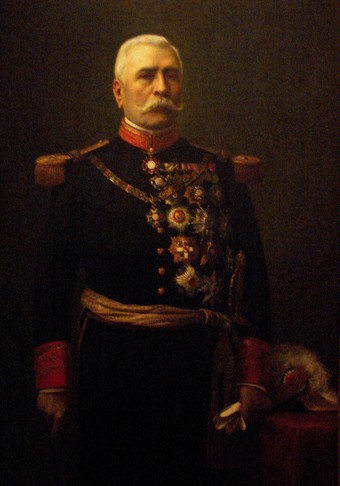
Porfirio Diaz
Diaz served as president of Mexico for 35 years.
The Campaign of “No Re-election”
In 1870, Diaz ran against President Juarez and Vice
President Lerdo de Tejada for president. Juarez won in July and
was confirmed by Congress in October, but Diaz claimed the election was fraudulent. Diaz launched the Plan de la Noria, a revolutionary call to arms
with the intent of ousting Mexican President Benito Juarez on November 8,
1871. The plan was supported by a number of local rebellions throughout the
country, but ultimately failed. Juarez died while in office in
1872, and when Vice President Lerdo succeeded him to the presidency, he offered
amnesty to the rebels, which Diaz accepted. Subsequently, Diaz took up
residency in Veracruz and served as the region’s representative in the
legislature.
Over time, opposition to Lerdo’s presidency grew as
anticlerical sentiment and labor unrest increased, and Diaz saw an
opportunity to plot a more successful rebellion. As a result, he left Mexico in
1875 for New Orleans and Brownsville, Texas, with his political ally Manuel
Gonzalez. A year later, he issued the Plan of Tuxtepec as a call to arms
against Lerdo, who was running for another presidential term. Lerdo was
re-elected in July 1876, but continued rebellion and political unrest before
and after the election forced him out of office. In November, Diaz occupied
Mexico City and Lerdo was exiled to New York. General Juan Mendez was named
provisional president, but Diaz was elected to the office in the beginning of
1877. One of Diaz’s government’s first actions was to amend the 1857 liberal
constitution to prevent re-election to the presidency.
Diaz initially served only one term in office in light of
his past resistance to Lerdo’s re-election policy. In order to side-step the
convention, he handpicked his successor, Manuel Gonzalez, with the intention of
maintaining his power in everything but name. During the four-year period of
Gonzalez’s rule, corruption and official incompetence abounded, so when Diaz
ran for office again in 1884, he was greeted with open arms by the public.
At that point, very few people remembered the “no re-election” promise
that had characterized his previous campaign, though some underground political
papers reversed his previous slogan, “Sufragio Efective, No Reeleccion”, to
“Sufragio Efectivo No, Reeleccion”. During his second term, Diaz amended the
constitution twice, initially allowing for two terms in office, then
removing all restrictions on re-election.
Political Career
As a popular military hero and astute politician, Diaz determined
that his main goal as president was to create the internal order necessary to
foster economic development throughout the country. His eventual establishment
of peace, termed the Pax Porfiriana, became one of his crowning achievements. To achieve this goal, Diaz created a systematic and methodical regime
with a staunch military mindset. He dissolved all local and federal-level
authorities that had once existed in order to ensure that all leadership
stemmed from his office. Legislative authorities that remained within Mexico
were stacked almost entirely with his closest and most loyal allies. Diaz also
suppressed the media and controlled the Mexican court system.
Diaz developed many pragmatic and personalist approaches to
the political conflicts that occurred during his first term in office. Although
known for standing with radical liberals, he made sure not to come across as a
liberal ideologue while in office and maintained control of his political
allies via generous systems of patronage. He was skilled at catering to interest groups and playing them off of one another to
create the illusion of democracy and quell rebellions before unrest began. He
maintained the structure of elections so that a facade of liberal democracy
remained during his rule, but his administration became famous for their
suppression of civil society and public revolts. He also paid the US $300,000
in settlement claims to secure recognition of his regime and met with
Ulysses S. Grant in 1878 while the latter visited Mexico.
Collapse
On February 17, 1908, Diaz gave an interview with an
American journalist, James Creelman of Pearson’s
Magazine, in which he stated that Mexico was ready for democracy and
elections. Diaz also stated that he would retire and allow other candidates to
compete for the presidency. Immediately, opposition groups began the search for
suitable candidates. As candidates began to campaign, Diaz decided he was not
going to retire, but instead run against a candidate he deemed appropriate. He
chose Francisco Madero, an aristocratic but democratically leaning reformer.
Madero was a landowner and very similar ideologically to Diaz, but hoped for
other Mexican elites to rule alongside the president. Ultimately, Diaz had Madero
jailed during the election.
Despite this, Madero gained substantial popular
support. However, when the results were announced, Diaz was proclaimed
re-elected almost unanimously in a massive display of electoral fraud, arousing
widespread anger throughout the country. Madero called for revolt against Diaz
and the Mexican Revolution began. Diaz was forced from office and fled the
country for Spain on
May
31, 1911.
36.1.2: The Mexican Revolution
The
Mexican Revolution took place over the course of a decade and radically
transformed Mexican culture and government.
Learning Objective
Outline
the events of the Mexican Revolution
Key Points
- The outbreak of the Mexican Revolution is
attributed to Porfirio Diaz’s failure in resolving the problem of presidential
succession. In the short term, events were precipitated by the results of the
1910 presidential election in which Diaz committed massive electoral fraud and
declared himself the winner against his then-jailed opponent, Francisco Madero. - Despite Madero’s lack of political experience,
his election as president in October 1911 raised high expectations for positive
change. These expectations were tempered by the Treaty of Ciudad Juarez, which stipulated
that certain essential elements of the Diaz regime, such as the federal army,
remain in place. - New institutional freedoms under Madero’s
regime and his failure to reward the revolutionary leaders who
brought him to power led to his resignation and the beginning of the
Huerta dictatorship. - Although Huerta’s regime attempted to legitimize
his hold on power and demonstrate its legality by pursuing reformist policies
in the first several months of his presidency, after October 1913, he
dropped all attempts to rule within a legal framework and murdered political
opponents while battling revolutionary forces that had united against his
regime. - On October 26, 1913, Huerta dispensed with the
Mexican legislature, surrounding the building with his army and arresting
congressmen he perceived to be hostile to his regime. Following a number of
military defeats, Huerta stepped down from the presidency and fled the country
less than a year later. - Huerta’s resignation marked the dissolution of
the federal army and the beginning of an era of civil war among the
revolutionary factions that united to oppose Huerta’s regime. - Venustiano Carranza and Pancho Villa’s forces
fought each other at the Battle of Celaya in April 6-15, 1915, which ended in
victory for the Constitutionalists and Carranza’s election to the presidency. -
As
revolutionary violence subsided in 1916, the leaders of Mexico met to draw up a
new, strongly nationalist constitution. Though Carranza was able to enact many
reforms, his regime remained vulnerable to Zapata in the south and Villa in the
north.
Key Terms
- Plan de Ayala
-
A
document drafted by revolutionary Emiliano Zapata during November 1911,
denouncing President Madero for his perceived betrayal of revolutionary ideals
and setting out a vision of future land reform. - Treaty of Ciudad Juarez
-
A
peace treaty signed between then-President of Mexico Porfirio Diaz and
revolutionary Francisco Madero on May 21, 1911, ending the fighting
between their respective forces and ending the initial phase of the Mexican
Revolution.
The Mexican Revolution was a major armed struggle from 1910 through 1920 that radically transformed Mexican culture and
government. Its outbreak is attributed to Porfirio Diaz’s failure to resolve the problem of presidential succession. In the short term, events were
precipitated by the results of the 1910 presidential election in which Diaz
committed massive electoral fraud and declared himself the winner against his
then-jailed opponent, Francisco Madero. Armed conflict ousted Diaz from power
and a new election was held in 1911, in which Madero won the presidency.
The Madero Presidency, 1911-1913
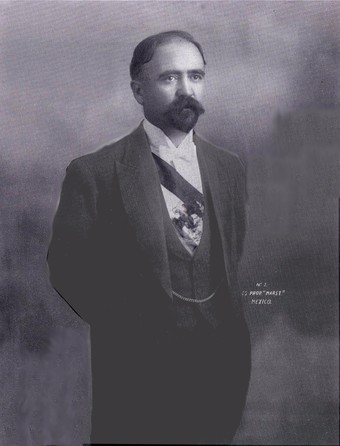
President Francisco I. Madero
Constitutional President of Mexico 1911-1913
Despite Madero’s lack of political experience, his election
as president in October 1911 raised high expectations for positive change.
However, these expectations were tempered by the Treaty of Ciudad Juarez,
signed on May 21, 1911, between Diaz and Madero, which put an end to fighting
between the two factions but also stipulated that certain essential elements of
the Diaz regime, such as the federal army, stay in place. Madero called for the
rebels who had brought him to power to return to civilian life. In their place,
Madero increasingly relied upon the federal army to deal with armed rebellions
that broke out in Mexico from 1911 to 1912.
The press, newly unencumbered by Madero’s less authoritarian
regime, embraced their newfound freedoms by making the president himself the object of
criticism. Organized labor exercised their newfound freedoms under the
Madero regime by staging strikes, which foreign entrepreneurs found threatening
to their business concerns. A rise in anti-American sentiment
accompanied these developments. The anarcho-syndicalist Casa del Obrero Mundial
was founded in September 1912 and served primarily as a center of agitation and
propaganda rather than exclusively as a labor union. A number of
political parties also proliferated across the country, including the National
Catholic Party, which was particularly strong in a number of regions.
Madero, unlike Diaz, failed to reward those who had brought
him to power, though many revolutionary leaders expected personal rewards or major
reforms in return for their service. Emiliano Zapata, in particular, long
worked for land reform in Mexico and expected Madero to make some major
changes. However, during a personal meeting with the guerrilla leader, Madero
told Zapata that the agrarian question needed careful study, giving rise to the
belief that Madero, a member of a rich northern landholding family, was
unlikely to implement comprehensive agrarian reform. In response, Zapata
drafted the Plan de Ayala in November 1911, declaring himself in
rebellion against Madero. Zapata renewed guerrilla warfare in the state of
Morelos and Madero was forced to send the federal army to deal, unsuccessfully,
with his forces.
Likewise, the northern revolutionary general Pascual Orozco
felt slighted after being put in charge of large forces of rurales in Chihuahua
instead of being chosen as governor of the same region. After being passed over
and witnessing Madero’s refusal to agree to social reforms calling for better
working hours, pay, and conditions, Orozco assembled his own army to rebel
against the president, aggravating U.S. businessmen and other foreign investors
in the northern region. For many, these upheavals signaled Madero’s inability
to maintain the order that had underpinned Diaz’s 35-year long regime. Madero
dispatched General Victoriano Huerta of the federal army to put down Orozco’s
revolt in April 1912. Ultimately, Huerta was successful in ending the
rebellion, leading many conservative forces to tout him as a powerful
counter-force to Madero’s regime.
A number of other rebellions occurred during a period known
as the Ten Tragic Days. During this time, U.S. Ambassador Henry Lane Wilson
brokered the Pact of the Embassy, formalizing an alliance between Huerta and Felix
Diaz, a nephew of the former president and rebel leader. The treaty ensured
that Huerta would become provisional president of Mexico following the
resignations of Madero and his vice president. However, rather than being sent
into exile, the two were murdered during transport to prison, which though
shocking did not prevent recognition of Huerta’s regime by most world
governments. Following the assumption of Huerta of the presidency, former
revolutionaries had no formally organized opposition to the established
government.
The Huerta Dictatorship, 1913-1914
Although Huerta’s regime attempted to legitimize his hold on
power and demonstrate its legality by pursuing reformist policies in the first
several months of his presidency, after October 1913 he dropped all
attempts to rule within a legal framework and murdered political opponents
while battling revolutionary forces that had united against his regime. For
these reasons, Huerta’s presidency is usually characterized as a dictatorship.
Huerta’s regime was supported initially by foreign and domestic business
interests, landed elites, the Roman Catholic Church, and the German and British
governments, and Mexico was militarized to a greater extent than ever before. Within
a month of the coup that brought Huerta to power, several rebellions broke out
across the country. The Northern revolutionaries fought under the name of the
Constitutionalist Army and Zapata continued his rebellion in Morelos under the
Plan de Ayala, despite Huerta’s interest in land reform as an issue. Huerta
offered peace to Zapata, but he rejected it.
Incoming U.S. President Woodrow Wilson refused to recognize
Huerta’s government despite the urging of Ambassador Wilson, who played a
key role in the regime change. In the summer of 1913, President Wilson recalled
Ambassador Wilson and sent his own personal representative John Lind to
continue U.S.-Mexican diplomatic relations. Lind was a progressive who
sympathized with the Mexican revolutionaries and urged other European powers to
join America in non-recognition of the Huerta regime. He also urged Huerta to
call elections and not step up as a candidate, using economic and military
threats to back up his pleadings. Mexican conservatives were also seeking an
elected civilian alternative to Huerta’s regime and brought together a number
of candidates in a National Unifying Junta. The fragmentation of the
conservative political landscape reinforced Huerta’s belief that he would not
be removed from power, whereas the proliferation of political parties and
presidential candidates proved to the country’s conservative elite that there
was a growing disillusionment with Huerta and his regime.
On October 26, 1913, Huerta dispensed with the Mexican
legislature, surrounding the building with his army and arresting congressmen
he perceived hostile to his regime. Congressional elections went ahead,
but the fervor of opposition candidates decreased. The October 1913 elections
ended any pretension of constitutional rule within Mexico and civilian
political activities were banned. Additionally, many prominent Catholics were
arrested and Catholic periodicals were suppressed. Huerta’s position continued
to deteriorate and his army suffered several defeats during this time. Finally,
in mid-July 1914, he stepped down and fled the country. He died six months
after going into exile after having been arrested by US authorities and held at
Fort Bliss, Texas. Huerta’s resignation also marked the dissolution of the
federal army and the beginning of an era of civil war among the revolutionary
factions that united to oppose Huerta’s regime.
War of the Winners, 1914-1915
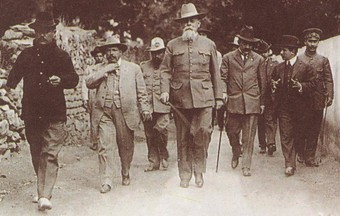
Venustiano Carranza
Photograph of Governor of Coahuila Venustiano Carranza (center), the tall and distinguished-looking “First Chief” of the Constitutionalist forces in northern Mexico opposing Huerta’s regime.
The revolutionary factions that remained in Mexico gathered
at the Convention of Aguascalientes in October 1914. During this time, there
was a brief break in revolutionary violence. Rather than facilitate a
reconciliation among the different factions, however, Venustiano Carranza and
Pancho Villa engaged in a power struggle, leading to a definitive break between
the two revolutionaries. Carranza expected to be named First Chief of the
revolutionary forces, but his supporters were overpowered during the convention
by Zapata and Villa’s supporters, who called on Carranza to resign executive
power. Carranza agreed to do so only if Villa and Zapata also resigned and went into exile. He also
stipulated that there be a pre-constitutionalist government to carry out the necessary political and social reforms the country needed
before a fully constitutional government was reestablished. As a result of these conditions, the
convention declared Carranza in rebellion and civil war resumed.
Northern general Villa formed an alliance with the southern
leader Zapata. The resultant combined forces were called the Army of the
Convention. In December 1914, their forces moved on Mexico City and captured
it, Carranza’s forces having fled shortly beforehand. In practice, however, the
Army of the Convention did not survive as an alliance beyond this initial
victory against the Constitutionalists. Shortly thereafter, Zapata returned to
his southern stronghold and Villa resumed fighting against Carranza’s forces in
the north. In the meantime, the United States sided with Carranza, who was based in American-occupied Veracruz. The United States timed its exit
from Veracruz to benefit Carranza, sending his forces munitions and
formally recognizing his government in 1915.
Villa’s forces met with those of Carranza’s allies at the
Battle of Celaya in April 6-15, 1915, which ended in a decisive
Constitutionalist victory due to their superior military tactics. As a result,
Carranza emerged as Mexico’s political leader with support from the army.
Constitutionalism Under Carranza, 1915-1920
As revolutionary violence subsided in 1916, the leaders of
Mexico met to draw up a new constitution. The Mexican Constitution of 1917 that
resulted was strongly national. Article 27 provided the government with the
right to expropriate natural resources from foreign interests, enabling land
reform. There were also provisions to protect organized labor and articles extending state power over the Roman Catholic Church within Mexico.
Carranza also pushed for women’s rights and equality during his presidency, which
helped to transform women’s legal status within the country.
Carranza, though able to enact many reforms, was
still vulnerable to revolutionary unrest. Zapata remained active in Morelos,
which due to its proximity to Mexico City remained a vulnerability for the
Carranza government. The Constitutionalist Army, renamed the Mexican National
Army, was dispatched to fight Zapata’s Liberating Army of the South, and government
agents assassinated Zapata in 1919. Carranza also sent generals to track down
Villa in the north, but they were only able to capture some of his men. Due to
the legacy of Diaz’s “no re-election” policy, it was politically untenable for
Carranza to seek re-election after his first term, so instead he endorsed political
unknown Ignacio Bonillas when his term in office was nearly finished. However,
some existing northern revolutionary leaders found the prospect of a civilian
Carranza puppet candidate untenable and hatched a revolt against Carranza
called the Plan of Agua Prieta. As a result, Carranza attempted to flee Mexico,
but died on his way to the Gulf Coast.
36.1.3: The National Revolutionary Party
The National Revolutionary Party held power
consistently from 1929 to 2000 by settling disputes among different
political interest groups within the framework of a single party machine.
Learning Objective
Describe the platform and political dominance of
the National Revolutionary Party
Key Points
- Political
unrest, including continued violence after the armed phase of the Mexican
Revolution, led to the foundation of the National Revolutionary Party, or PNR. - The PNR would
undergo name changes over the years it remained in power. In 1938 its name was
changed to Partido de la Revolucion Mexicana (PRM), and in 1946, the party was
renamed Partido Revolucionario Institucional (PRI). - The party was split
functionally into mass organizations that represented various interest
groups. Settling disputes within the framework of a single political party
helped prevent legislative gridlock and militarized rebellions, but only
provided an illusion of democracy to its constituents. - Over time, the party became synonymous with political corruption and
voter suppression, and the growth of opposition parties led to the PRI’s loss of
the presidency in 2000.
Key Terms
- National Revolutionary Party
-
The Mexican political party founded in 1929 that
held executive power within the country for an uninterrupted 71 years. It
underwent two name changes during its time in power: once in 1938, to Partido
de la Revolucion Mexican (PRM), and again in 1946, to Partido Revolucionario
Institucional (PRI). - Democratic Current
-
A movement within the PRI founded in 1986 that
criticized the federal government for reducing spending on social programs to
increase payments on foreign debt. PRI members who participated in the
Democratic Current were expelled from the party and formed the National
Democratic Front (FDN).
History
Although the armed phase of
the Mexican Revolution ended in 1920, Mexico continued to experience political
unrest in the years that followed. In 1928, president-elect Alvaro Obregon was
assassinated, giving rise to a political crisis. This led to the founding
of the National Revolutionary Party (in Spanish, Partdio Nacional
Revolucionario, or PNR) the following year by sitting president Plutarco Elias
Calles. Calles’ intention in founding the PNR was to end the violent
power struggles taking place between factions of the Mexican
Revolution and guarantee the peaceful transmission of power across presidential
administrations. In the first years of the PNR’s existence, it was the
only political machine in existence. In fact, from 1929 until 1982, the PNR won
every presidential election by well over 70 percent of the vote.
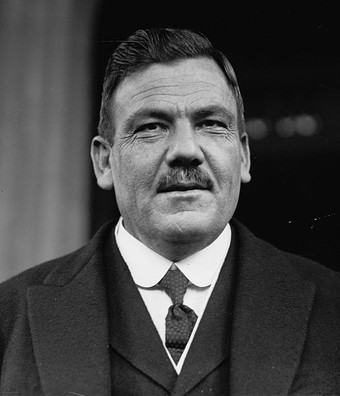
Plutarco Elias Calles
Plutarco Elías Calles, president of Mexico (1924-28) and founder of the PNR in 1929.
In 1938, Lazaro Cardenas,
the president of Mexico at the time, renamed the PNR to Partdio de la
Revolucion Mexicana, or PRM. The PRM’s revised aim was to establish a socialist
democracy of workers. In practice, however, this was never achieved, and the
PRM was split functionally into many mass organizations that
represented different interest groups. Settling disputes within the framework
of a single political party helped to prevent legislative gridlock and
militarized rebellions, which were common during the Mexican
Revolution. For these reasons, its supporters maintained that the party itself
was crucial to the modernization and stability of Mexico as a whole. In fact,
the first four decades of PRM rule were dubbed the “Mexican Miracle” due to the
economic growth that occurred as a result of import substitution, low
inflation, and the implementation of successful national development plans. Between
1940 and 1970, Mexican GDP increased sixfold and peso-dollar parity was
maintained. Party detractors, however, pointed to the lack of transparency and
democratic processes, which ultimately made the lower levels of administration
subordinate to the whims of the party machine.
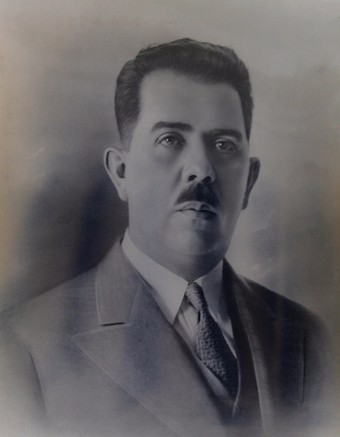
Lázaro Cárdenas
Lázaro Cárdenas, president of Mexico (1934-40).
Corruption and Opposing
Political Parties
As in previous regimes, the
PRM retained its hold over the electorate due to massive electoral fraud.
Toward the end of every president’s term, consultations with party leaders
would take place and the PRM’s next candidate would be selected. In other
words, the incumbent president would pick his successor. To support the party’s
dominance in the executive branch of government, the PRM sought dominance at
other levels as well. It held an overwhelming majority in the Chamber of
Deputies as well as every seat in the Senate and every state governorship.
As a result, the PRM became a symbol over time of corruption, including
voter suppression and violence. In 1986, Cuauhtemoc Cardenas, the former
Governor of Michoacan and son of the former president Lazaro Cardenas, formed
the Democratic Current, which criticized the federal government for reducing
spending on social programs to increase payments on foreign debt. Members of
the Democratic Current were expelled from the party, and in 1987, they formed
the National Democratic Front, or Frente Democratico Nacional (FDN). In 1989, the
left wing of the PRM, now called Partido Revolucionario Institucional, or PRI, went
on to form its own party called the Party of the Democratic Revolution. The
conservative National Action Party, likewise, grew after 1976 when it obtained
support from the business sector in light of recurring economic crises. The
growth of both these opposition parties resulted in the PRI losing the
presidency in 2000.
36.1.4: The Mexican Economic Miracle
The Mexican Economic Miracle refers to the
country’s inward-focused development strategy, which produced sustained
economic growth form the 1940s until the 1970s.
Learning Objective
Explain the Mexican
Economic Miracle
Key Points
- The reduction of
political turmoil that accompanied national elections during and
immediately after the Mexican Revolution was an important factor in laying the
groundwork for economic growth. - During the
presidency of Lazaro Cardenas, significant policies were enacted in the social
and political spheres that had major impacts on the economic policies of the
country as a whole. - The Mexican
government promoted industrial expansion through public investment in
agricultural, energy, and transportation infrastructure. - Growth was
sustained by Mexico’s increasing commitment to provide quality education
options for its general population. - Mexico benefited
substantially from World War II due to its participation supplying labor and
materials to the Allies. - In the years following World War II, President Miguel Aleman Valdes
(1946-52) instituted a full-scale import-substitution program that stimulated
output by boosting internal demand.
Key Terms
- Bracero Program
-
A series of laws and diplomatic agreements
initiated on August 4, 1942, that guaranteed basic human rights and a minimum
wage of 30 cents an hour to temporary contract laborers traveling from Mexico
to the United States. - import substitution industrialization
-
A trade and economic policy that advocates
replacing foreign imports with domestic production.
The Mexican Economic Miracle
refers to the country’s inward-focused development strategy, which produced
sustained economic growth of 3-4 percent with modest 3 percent inflation
annually from the 1940s until the 1970s.
Creating the Conditions for
Growth
The reduction of political
turmoil that accompanied national elections during and immediately after
the Mexican Revolution was an important factor in laying the groundwork for
economic growth. This was achieved by the establishment of a single,
dominant political party that subsumed clashes between various interest groups
within the framework of a unified party machine. During the presidency of
Lazaro Cardenas, significant policies were enacted in the social and political
spheres that had major impacts on the economic policies of the country. For instance, Cardenas nationalized oil concerns in 1938. He also
nationalized Mexico’s railways and initiated far-reaching land reform.
Some of these policies were
carried on, albeit more moderately, by Manuel Avila Camacho, who succeeded him
to the presidency. Camacho initiated a program of industrialization in early
1941 with the Law of Manufacturing Industries, famous for beginning
the process of import-substitution within Mexico. Then in 1946, President Miguel
Aleman Valdes passed the Law for Development of New and Necessary Industries,
continuing the trend of inward-focused development strategies.
Growth was sustained by
Mexico’s increasing commitment to primary education for its general population.
The primary school enrollment rate increased threefold from the late 1920s
through to the 1940s, making economic output more productive by the 1940s.
Mexico also made investments in higher education during this period, which
encouraged a generation of scientists and engineers to enable new levels of
industrial innovation. For instance, in 1936 the Instituto Politecnico Nacional
was founded in the northern part of Mexico City. Also in northern Mexico, the
Monterrey Institute of Technology and High Education was founded in 1942.
World War II
Mexico benefited substantially from World War II by supplying labor and materials to the
Allies. The Bracero Program was a series of laws and diplomatic agreements
initiated on August 4, 1942, that guaranteed basic human rights and a minimum
wage of 30 cents an hour to temporary contract laborers who came to the United
States from Mexico. Braceros, meaning manual laborer, literally “one who
works using his arms”, were intended to fill the labor shortage in agriculture
due to conscription. The program outlasted the war and offered employment
contracts to 5 million braceros in 24 U.S. states, making it the
largest foreign worker program in U.S. history. Mexico also received cash
payments for its contributions of materials useful to the war effort, which
infused its treasury with reserves. With these robust resources building up
after the war concluded, Mexico was able to embark on large infrastructure
projects.
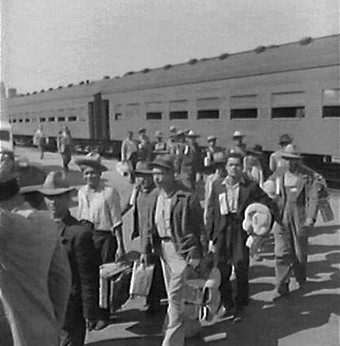
Braceros
Some of the first Braceros arriving in Los Angeles by train in 1942.
Camacho used part of the
accumulated savings from the war to pay off foreign debts, which improved
Mexico’s credit substantially and increased investors’ confidence in the
government. The government was also in a better position to more widely distribute material
benefits from the Revolution given the robust revenues from the war
effort. Camacho used funds to subsidize food imports that affected urban
workers. Mexican workers also received high salaries during the
war, but due to the lack of consumer goods, spending did not increase
substantially. The national development bank, Nacional Financiera, was
founded under Camacho’s administration and funded the expansion of the
industrial sector.
Import-Substitution and
Infrastructure Projects
In the years following World
War II, President Miguel Aleman Valdes (1946-52) instituted a full-scale
import-substitution program that stimulated output by boosting internal demand.
The economic stability of the country, high credit rating, increasingly
educated work force, and savings from the war provided excellent conditions
under which to begin a program of import substitution industrialization. The
government raised import controls on consumer goods but relaxed them on capital
goods such as machinery. Capital goods were then purchased using international
reserves accumulated during the war and used to produce consumer goods
domestically. The share of imports subject to licensing requirements rose from
28 percent in 1956 to more than 60 percent on average during the 1960s and
approximately 70 percent during the 1970s. Industry accounted for 22 percent of
total output in 1950, 24 percent in 1960, and 29 percent in 1970. One industry
that was particularly successful was textile production. Mexico became a
desirable location for foreign transnational companies like Coca-Cola,
Pepsi-Cola, and Sears to establish manufacturing branches during this period. Meanwhile,
the share of total output arising from agriculture and other primary activities
declined during the same period.
The Mexican government
promoted industrial expansion through public investment in agricultural,
energy, and transportation infrastructure. Cities grew rapidly after 1940,
reflecting the shift of employment towards industrial and service centers
rather than agriculture. To sustain these population changes, the government
invested in major dam projects to produce hydroelectric power, supply drinking
water to cities and irrigation water to agriculture, and control flooding. By
1950, Mexico’s road network had also expanded to 21,000 kilometers, some 13,600
of which were paved.
Mexico’s strong economic performance continued into the 1960s when GDP
growth averaged around seven percent overall and approximately three percent
per capita. Consumer price inflation also only averaged about three percent
annually. Manufacturing remained the country’s dominant growth sector,
expanding seven percent annually and attracting considerable foreign
investment. By 1970, Mexico diversified its export base and became largely
self-sufficient in food crops, steel, and most consumer goods. Although imports
remained high, most were capital goods used to expand domestic production.
36.1.5: Art and Culture in 20th-Century Mexico
The Mexican Modernist School used large-scale
murals to reinforce political messages, especially those that emphasized
Mexican rather than European themes.
Learning Objective
Give examples of major works of art in Mexico
during the 20th century
Key Points
- The Mexican
Revolution had a dramatic effect on Mexican art, and the Mexican government commissioned
murals for public buildings to reinforce political messages, especially those
that emphasized Mexican rather than European themes. - The Mexican muralist
movement reached its height in the 1930s with four main artists: Diego
Rivera, David Alfaro Siqueiros, Jose Clemente Orozco,and Fernando Leal. It is
now the most studied aspect of Mexico’s art history. - Diego Rivera’s murals
were greatly influenced by his leftist political leanings, dealing with Mexican
society and reflecting the country’s 1910 Revolution. - Frida Kahlo de Rivera was a Mexican painter known for her
self-portraits. Though she painted canvases instead of murals, she is still
considered part of the Mexican Modernist School due to the emphasis of Mexican
folk culture and use of color in her works.
Key Terms
- Mexican Modernist School
-
The artistic movement within Mexico that was especially
prolific in the 1930s, glorifying the
Mexican Revolution and redefining the Mexican people vis-à-vis their
indigenous and colonial past. Large-scale murals were its preferred
medium. - surrealist
-
A cultural and artistic movement that mixed dream
and reality into one composition.
Mexican Muralism and
Revolutionary Art
The Mexican Revolution had a
dramatic effect on Mexican art. The government allied itself with
intellectuals and artists in Mexico City and commissioned murals for public
buildings to reinforce political messages, especially those that emphasized
Mexican rather than European themes. The production of art in conjunction with
government propaganda is known as the Mexican Modernist School, or the Mexican
Muralist Movement. Many such works glorified the Mexican Revolution or
redefined the Mexican people vis-à-vis their indigenous and colonial past. The
first of these commissioned works was done by Fernando Leal, Fermin Revueltas,
David Alfaro Siqueiros, and Diego Rivera at San Ildefonso, a prestigious Jesuit
boarding school.
The muralist movement
reached its height in the 1930s with four main artists: Diego Rivera,
David Alfaro Siqueiros, Jose Clemente Orozco, and Fernando Leal. It is now the
most studied aspect of Mexico’s art history. These four artists were
trained in classical European techniques and many of their early works were
imitations of then-fashionable European paintings styles. Many Mexican government buildings featured murals glorifying Mexico’s pre-Hispanic past and incorporating it into the
definition of Mexican identity. Many of these muralists also revived the fresco
technique in their mural work, although some like Siqueiros moved to industrial
techniques and materials such as the application of pyroxilin, a commercial
enamel used for airplanes and automobiles.
Diego Rivera
Rivera painted his first
significant mural, Creation, in the
Bolivar Auditorium of the National Preparatory School in Mexico City in January
1922 while guarding himself with a pistol against right-wing students. In the
autumn of 1922, Rivera participated in the founding of the Revolutionary Union
of Technical Workers, Painters and Sculptors, and later that year he joined the
Mexican Communist Party. His murals were greatly influenced by his leftist political
leanings, dealing with Mexican society and reflecting the country’s 1910
Revolution. He developed his own native style based on large, simplified
figures and bold colors. A strong Aztec influence was present in his works, and much of his art emulated the Mayan steles
of the classical era.
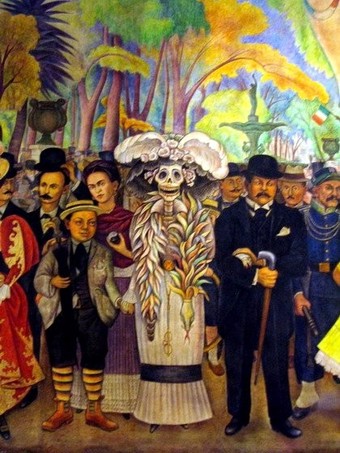
Mural by Diego Rivera
Mural Sueño de una Tarde Dominical en la Alameda Central in Mexico City, featuring Rivera and Frida Kahlo standing by La Calavera Catrina.
Frida Kahlo
Frida Kahlo de Rivera was a Mexican painter known for her
self-portraits. While she painted canvases instead of murals, she is still
considered part of the Mexican Modernist School due to the emphasis of Mexican
folk culture and use of color in her works. She was married to muralist Diego
Rivera and like Rivera was an active communist. Kahlo was influenced by
indigenous Mexican culture as demonstrated by her use of bright colors,
dramatic symbolism, and primitive style. She often included monkeys in her
works; while this is usually a symbol of lust in Mexican mythology, Kahlo’s portrayal was tender and protective. Christian and Jewish themes
were often depicted in Kahlo’s work. She combined elements of classic
religious Mexican traditions with surrealist components in her paintings.
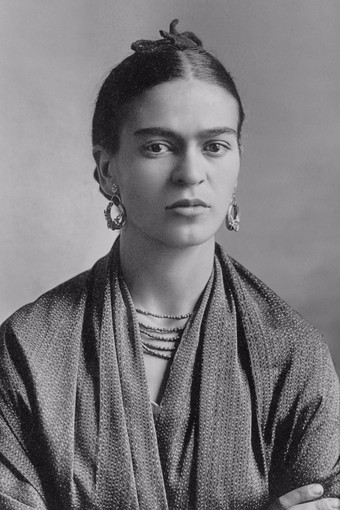
Frida Kahlo by Guillermo Kahlo
Kahlo in 1932, photographed by her father, Guillermo.
36.2: Argentina
36.2.1: Argentina Before the Great Depression
Argentina, a non-industrialized country,
experienced recession after World War I and before the global depression hit,
but unlike neighboring countries, maintained relatively healthy growth rates
throughout the 1920s.
Learning Objective
Describe Argentina’s economic status before the
global depression hit.
Key Points
- Argentina was
not an industrialized country in the lead-up to the Great Depression and lacked the energy sources necessary to make it so. - One of Argentina’s
most lucrative industries was agriculture, and its exports of frozen beef,
especially to Great Britain, proved highly profitable. - Argentina, like
many other countries, entered a recession after the beginning of World War
I as the international flow of goods, capital, and labor declined. - Foreign
investment in Argentina came to a complete standstill from which the country
never fully recovered. - Nonetheless, Argentina maintained relatively healthy growth
throughout the 1920s, unlike neighboring countries, because it was relatively unaffected
by the worldwide collapse on commodity prices. However, the global depression
would eventually halt economic expansion within the country.
Key Term
- Southern
Cone -
A geographic region composed of the southernmost areas of South America, south of and around the Tropic of Capricorn.
Traditionally, it is comprised of Argentina, Chile, and Uruguay.
It is bounded on the west by the Pacific Ocean and to the south by the junction
between the Pacific and Atlantic Oceans.
Argentina was not an
industrialized country by the standards of Britain, Germany, or the United
States in the lead-up to the Great Depression, and lacked energy sources
such as coal or hydropower to make it so. Experiments in oil extraction during
the early 20th century had poor results. Yacimientos Petroliferos
Fiscales (YPF), the first state-owned oil company in Latin America, was founded
in 1922 as a public company responsible for 51% of oil production, with the
remaining 49% in the hands of private concerns. Moreover, one of Argentina’s
most lucrative industries was agriculture, and its exports of frozen beef,
especially to Great Britain, proved highly profitable following the invention
of refrigerated ships in the 1870s.
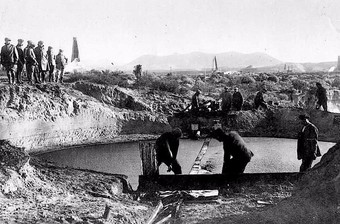
YPF workers (1923)
YPF workers are shown working on an oil well in 1923.
Argentina, like many other
countries, entered a recession following the beginning of World War I as the
international flow of goods, capital, and labor declined. Additionally,
following the opening of the Panama Canal in 1914, Argentina and other Southern
Cone economies declined as investors turned their sights to Asia and the
Caribbean. Even beef exports took a hit as Britain imposed new restrictions on
meat imports in the late 1920s. Argentinian ranchers responded by switching
from pastoral to arable production, but lasting damage had already been done to
the Argentine economy. The United States viewed Argentina, and to a lesser
extent Brazil, as a potential rival on the world markets, making collaboration
less likely between the two countries. In light of the United States’ emergence
from WWI as a political and financial superpower, this would prove particularly
harmful to Argentina.
Meanwhile, foreign
investment into Argentina came to a complete standstill from which the country
never fully recovered. As a result, investable funds became concentrated over
time at a single institution: the Banco de la Nacion Argentina (BNA). This made
Argentina’s financial system vulnerable to rent-seeking. Re-discounting and
non-performing loans grew steadily at the BNA after 1914 as a result of crony
loans to other banks and the private sector, polluting the bank’s balance
sheet. The state bank allowed private banks to shed their risks, using money
not backed by collateral as security, then lent the private banks cash at a
rate of 4.5%, below the rate the BNA offered to its customers on certificates
of deposit. Ultimately, neither the Buenos Aires Stock Exchange nor any of the
private domestic banks within the country would develop rapidly enough to
fully replace the loss of foreign capital, the bulk of which was sourced
from now heavily indebted Great Britain.
Nonetheless, Argentina maintained relatively healthy growth
throughout the 1920s, unlike neighboring countries like Brazil and Chile,
because it was relatively unaffected by the worldwide collapse on commodity
prices. Similarly, unlike many European countries that abandoned it, the
gold standard was still in place in Argentina during this time, contributing to
the country’s relative financial stability. Automobile ownership in the country
at 1929 was the highest in the Southern hemisphere, an indicator of the
healthy purchasing power of the middle class on the eve of the Great
Depression. However, the economic downturn would eventually
halt economic expansion within the country.
36.2.2: The Infamous Decade
The 1930s in Argentina is referred to as the
Infamous Decade due to rampant electoral fraud, persecution of political
opposition parties, and generalized government corruption.
Learning Objective
Explain why the 1930s were referred to as the
Infamous Decade
Key Points
- Argentina’s
Infamous Decade refers to the period of time that began in 1930 with Jose Felix
Uriburu’s coup d’etat against standing President Hipolito Yrigoyen and ended
with Juan Peron’s rise to power after the military coup of 1943. - Lieutenant
General Uriburu’s regime was strongly supported by rightist intellectuals and
his government adopted severe measures to prevent reprisals and
counter-revolutionary tactics by friends of the ousted regime. - Agustin Pedro
Justo Rolon’s administration was tarnished by constant rumors of corruption and is best remembered for the outstanding diplomatic work of
his Foreign Minister. - One of the most
controversial successes of Justo’s presidency is the signing of the
Roca-Runciman Treaty in 1933. - Justo’s first
minister of the Treasury, Alberto Hueyo, took very restrictive measures against
the economy. Hueyo was eventually replaced by Frederico Pinedo, whose plan for
government intervention into the economy was even more significant. - Pinedo began
Argentinian industrial development via a policy of import substitution and
created Argentina’s Central Bank. - Roberto
Marcelino Ortiz was fraudulently elected president and assumed his office in
February 1938. He attempted to clean up the country’s corruption problem and
cancelled fraudulent elections won by conservative Alberto
Barcelo. - In June 1942,
Ortiz resigned the presidency due to sickness and died a month later. He was
replaced by Vice President Ramon S. Castillo. - On June 4, 1943,
a nationalist secret society within the army called the Grupo de Oficiales
Unidos (GOU) overthrew Castillo in a coup.
Key Terms
- import substitution
-
A trade and economic policy that advocates
replacing foreign imports with domestic production. - Infamous Decade
-
The period of time in Argentina beginning in
1930 characterized by electoral fraud, the persecution of political opposition,
and generalized government corruption.
Argentina’s Infamous Decade
refers to the period of time that began in 1930 with Jose Felix Uriburu’s coup
d’etat against standing President Hipolito Yrigoyen and ended with Juan Peron’s rise to power after the military coup of 1943. The decade is marked by
a significant rural exodus as many small rural landowners were ruined by the
global depression, which ultimately pushed Argentina towards a policy of import
substitution industrialization. The poor economic results of this policy and
the popular discontent it engendered led directly to the coup in 1943. The
period was characterized by electoral fraud, the persecution of political
opposition, and generalized government corruption.
Uriburu’s Presidency
(1930-1932)
Lieutenant General Jose
Felix Benito Uriburu y Uriburu achieved the position of President of Argentina via
military coup, and his tenure lasted from September 6, 1930 until February 20,
1932. Known as the “father of the poor”, standing president Hipolito Yrigoyen
was overwhelmingly elected to his second non-consecutive term in office in
1928, but found himself increasingly surrounded by aides who hid the true
effects of the Great Depression on the country from him. As a result, fascist
and conservative sectors of the army plotted openly for regime change, as did
Standard Oil of New Jersey, an American company that opposed both the
president’s efforts to curb oil smuggling from Salta Province to Bolivia and
the dominance YPF held over the Argentinian oil market. These factors made the
timing perfect for Uriburu to stage Argentina’s first military coup since the
adoption of the Argentine constitution against Yrigoyen’s
democratically-elected administration with the help of the far-right Argentine
Patriotic League.
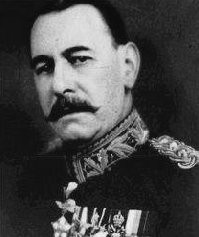
Jose Felix Uriburu
Jose Felix Uriburu was the 22nd president of Argentina.
Uriburu’s own regime was
strongly supported by rightist intellectuals such as Rodolofo and Julio
Irazusta and Juan Carulla, and the new government adopted severe measures to
prevent reprisals and counter-revolutionary tactics by friends of the ousted
regime. Anarchists in particular were considered public enemies by Uriburu’s
dictatorship. During Uriburu’s regime, three anarchists were given life
sentences for allegedly assassinating family members of conservative
politician Jose M. Blanch during a show trial in which the anarchists were
openly tortured. The show trial came on the heels of the Sacco and Vanzetti
case in the United States, in which two Italian-born American anarchists were
given the death penalty after being found guilty of murder in what was widely
regarded as a politically motivated sentencing. The Argentinian case drew many
parallels to Sacco and Vanzetti and raised international public indignation.
President Uriburu was
diagnosed with stomach cancer in early 1932 and died in Paris following surgery on April 29, 1932.
Justo’s Presidency
(1932-1938)
Agustin Pedro Justo Rolon
was president of Argentina from February 20, 1932, until February 20, 1938. He
was a military officer, diplomat, and politician. Justo earned the
Concordance’s nomination for the 1931 presidential campaign and won with the support
of an alliance created between the National Democratic Party, the Radical Civic
Union, and the Socialist Independent Party. Nonetheless, accusations of
electoral fraud abounded and Justo’s administration was tarnished by constant
rumors of corruption. His administration is best remembered for the outstanding
diplomatic work of his Foreign Minister, Carlos Saavedra Lamas.

Agustin P. Justo
Agustin P. Justo was the 23rd president of Argentina.
The Roca-Runciman Treaty
One of the most
controversial successes of Justo’s presidency is the signing of the
Roca-Runciman Treaty in 1933. Due to the UK’s adoption of measures favoring
imports from its own colonies and dominions, Justo sent his vice president,
Julio A. Roca Jr, as head of a technology delegation to negotiate a commercial
agreement that might benefit Argentina. The British were previously the
main buyers of Argentinian grain and meat, making their production
protectionism measures threatening to Argentinian landowners who traded in
these agricultural products. The Roca-Runciman Treaty
assured the UK a provision of fresh meat in exchange for important investment
in Argentina’s transportation, requiring certain concessions such as
handing over Buenos Aires’ public transport to a British company. The treaty
created a scandal because although the UK agreed to continue importing
Argentinian meat, they allotted Argentina an import quota less than any
of its dominions: 390,000 tons of meat per year, with 85% of Argentine exports
arranged via British refrigerated shippers. There were other far-reaching concessions as well; for instance, railways operated by the UK did not have regulated tariffs in
place, customs fees over coal remained unestablished, and British companies
with investments in Argentina were given a number of special dispensations,
such as reduced export pricing. Although the Roca-Runciman Treaty salvaged the
Argentinian-British trade in agricultural products, it exasperated those
already critical of British involvement in their country.
Hueyo and Pinedo’s Economic
Policies
Justo’s first minister of
the Treasury, Alberto Hueyo, took very restrictive measures against the economy.
Hueyo reduced public expenses and restricted the circulation of currency in
addition to applying other harsh fiscal measures. An emprestito patriotico, or
patriotic loan, was made in an attempt to strengthen the country’s budget.
Eventually, however, Justo sought to replace Hueyo with the socialist Frederico
Pinedo, whose plan for government intervention into the economy was even more
significant.
Pinedo began Argentinian
industrial development via a policy of import substitution. The Juntas Reguladores
Nacionales was created under Pinedo’s guidance to help develop private
and state industrial activity. The Juntas also oversaw quality and price control
for domestic consumption and export. For example, to avoid
overproduction, the Juntas destroyed entire loads of corn and millions of pesos
per year in wine products.
Pinedo also created the
Central Bank (BCRA), which was advised by Sir Otto Niemeyer, the director of
the Bank of England. Niemeyer’s involvement drew heavy criticism from those who
disavowed British involvement in Argentina. A national project of road
construction was launched that competed with the railway
system, which remained in the hands of mostly British companies. With national
roadways reaching 30,000 kilometers in 1938, U.S. automotive firms were able to
penetrate the Argentinian market and increase sales. U.S. foreign direct
investment grew under Pinedo’s policies with textile firms like Sudamtex,
Ducilo, and Anderson Clayton establishing themselves in Argentina. Tire
companies, electronics firms, and chemistry firms also began to migrate to
Argentina during this time.
The Ortiz and Castillo
Administrations (1938-1943)
Roberto Marcelino Ortiz and
Ramon S. Castillo’s candidacies for the 1938 elections, for president and vice
president respectively, were launched at the British Chamber of Commerce and
supported by its president, William McCallum. Ortiz was fraudulently elected
president and assumed his new office in February 1938. He attempted to clean up
the country’s corruption problem, ordering federal intervention in the Province
of Buenos Aires, which was governed by Manuel Fresco. He also cancelled
fraudulent elections won by conservative Alberto Barcelo.
Pinedo remained as the Minister
of the Economy during Ortiz’s administration. On November 18, 1940, he
presented an Economic Reactivation Plan, which would have implemented heavily
protectionist measures and advocated for the building of public housing to deal
with the influx of people into urban centers. Pinedo also proposed
nationalization of the British-operated railways and even agreed upon
advantageous terms with the railway owners before presenting his policy
publicly. Nevertheless, conservative factions voted against these measures,
and Pinedo resigned his office shortly thereafter.
During World War II,
Argentina maintained the same neutrality it adopted during the first World
War, which was advantageous for Great Britain. Although the USA attempted to
push Argentina into the war, the country was able to resist with support from
the British. In June 1942, Ortiz resigned the presidency due to sickness and
died a month later. He was replaced by Vice President Castillo. The same year,
the Democratic Union political coalition, which included the Radical Civic
Union, the Democratic Progressive Party, and the Socialist and Communist
parties, was formed. Their electoral platform aimed to tackle endemic
corruption, guarantee freedom of thought and assembly, and secure labor union
rights. The coalition also claimed active solidarity with people struggling
against Nazi-Fascist aggression.
On June 4, 1943, the nationalist secret society within the army called
the Grupo de Oficiales Unidos (GOU) overthrew Castillo in a coup. The GOU was organized under Colonel Miguel A. Montes and Urbano de la Vega and
included members such as Colonel Juan Domingo Peron and Enrique P. Gonzalez.
Their coup d’etat ended the Infamous Decade and established a military junta
that lasted until 1945. The group was sympathetic to the causes of Nazi Germany
and Fascist Italy. General Arturo Rawson was made president, but only held
office for a few days before the GOU replaced him with General Pedro Ramirez.
36.2.3: Peronism
The
Argentinian political movement Peronism is based on three main principles:
social justice, economic independence, and political sovereignty.
Learning Objective
Outline
the key characteristics of Peronism
Key Points
- Peronism, or Justicialism, is an Argentine
political movement based on the political legacy of former President Juan
Domingo Peron and his second wife, Eva Peron. - The pillars of the Peronist ideal, known as the
“three flags,” are social justice, economic independence, and political
sovereignty. - Peron’s ideas were widely embraced by a variety
of groups in Argentina across the political spectrum, and since its
inception in 1946, Peronist candidates have won nine out of 12 presidential
elections from which they have not been banned. - Defenders of Peronism describe the doctrine as
populist in the sense that they believe it embodies the interests of the
masses, and in particular, the most vulnerable members of society. - Peron’s opponents, however, view Peronism was an
authoritarian ideology, compare Juan Peron to fascist dictators, accuse him of
demagoguery, and deride his policies as too populist. - Eva Peron, popularly known as Evita, was
instrumental as a symbol of hope to the common laborer during her husband’s
first five-year plan. Her strong ties to the poor lent credibility to Juan
Peron’s first presidential term and ushered in a new wave of supporters to his
regime. - Evita established the Eva Peron Foundation in
1948 and ran as the vice presidential candidate with Juan Peron during the 1951
election.
Key Terms
- third position ideology
-
A
political ideology that emphasizes opposition to both communism and capitalism.
Proponents typically depict themselves as beyond the left or right wings of
politics while borrowing ideas from each end of the spectrum. - corporatism
-
Also
known as corporativism, corporatism is the sociopolitical organization of
society by major interest, or corporate, groups.
Peronism, or Justicialism, is an Argentine political
movement based on the political legacy of former President Juan Domingo Peron
and his second wife, Eva Peron. The Justicialist Party derives its name from
the concept of social justice. Since its inception in 1946, Peronist candidates
have won nine out of 12 presidential elections from which they have not been
banned. As of 2016, Peron was the only Argentinian to have been elected
president three times.
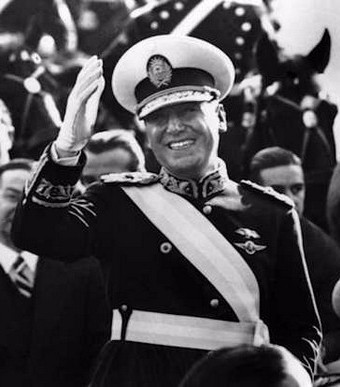
Juan Peron wearing the presidential sash
President Peron at his 1946 inaugural presidential parade.
Ideology
The pillars of the Peronist ideal, known as the “three
flags,” are social justice, economic independence, and political sovereignty.
Peronism is considered a third-position ideology because it rejects both
capitalism and communism. Peronism advocates corporatism as a means for
mediating tensions within society, with the state responsible for negotiating
compromises if conflicts arise. Traditionally, its adherents come primarily from
the working class and unions, and the ideology has been described as
proletarian in nature. Peronism, however, is a generally ill-defined ideology, with contradictory statements sometimes expressed in its name. The
legacy of Peron is thought to transcend the confines of any
political party in modern times and blend into the broader political
landscape of Argentina.
Peron’s ideas were widely embraced by a variety of groups in Argentina across the political spectrum. Peron’s personal views later
became a burden on the ideology, however. For example, his anti-clericalism did
not strike a sympathetic chord with upper-class Argentinians. Peron’s public
speeches were consistently nationalist and populist. In fact, Peronism draws
many parallels with corporate nationalism due to the nationalization of many
Argentinian corporations during Peron’s administrations. At the same time,
labor unions became more corporate in nature, ceding the right to strike in the
early to mid-1940s.
Defenders of Peronism describe the doctrine as populist in that they believe it embodies the interests of the masses,
especially the most vulnerable members of society. Admirers hold Peron
in esteem for his administration’s anti-imperialism, non-alignment, and
socially progressive initiatives. Peron’s governments made social security
universal, education free for all who qualified, and provisions for one paid
week off before every major examination for working students. Vast low-income
housing projects were created and paid vacations became standard. All workers
were guaranteed free medical care and mothers were given three paid months off
prior to and after giving birth. Workers’ recreation centers were constructed
all over the country , including a vast resort in the lower Sierras de Cordoba
that included eight hotels, riding stables, swimming pools, movie theaters, and
scores of cabins.
From the perspective of Peron’s opponents, however, Peronism
was an authoritarian ideology. Peron was often compared to fascist dictators,
accused of demagoguery, and his policies derided as too populist. Claiming
to be an embodiment of Argentinian nationality, Peron’s government often silenced
dissent by accusing opponents of being unpatriotic. Peron’s corporatism also
drew attack from socialists who accused his administration of preserving
capitalist exploitation and class division. Conservatives, on the other hand,
rejected his modernist ideology and felt their status was threatened by the
ascent of Peron’s governing officials. Liberals condemned Peron for his
regime’s arbitrariness and dictatorial tendencies.
Influence and Contributions of Eva Peron
Eva Peron, popularly known as Evita, was instrumental as a
symbol of hope to the common laborer during her husband’s first five-year plan.
Her strong ties to the poor lent credibility to Juan Peron’s first presidential
term and ushered in a new wave of supporters to his regime. She was loathed by
the elite due to her humble origins, but adored by the poor for her work with the
sick, elderly, and orphans. She was involved in behind-the-scenes work to
secure women’s suffrage in 1947 and supported a women’s movement that
concentrated on the rights of women, the poor, and the disabled. The extent of her
role in her husband’s first term remains disputed, although it is clear that
she was responsible for introducing social justice and equality into the
national discourse. It is speculated that Eva’s influence on her husband led to
the stipulations within the five-year plans that called for full employment,
public healthcare and housing, labor benefits, raises, and humanitarian relief
efforts.
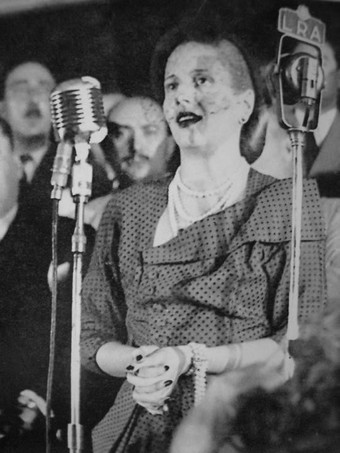
Eva Peron
Eva Peron, known as Evita, worked to secure women’s suffrage, which was granted in 1947.
Evita established the Eva Peron Foundation in
1948. Enjoying an annual budget of approximately USD 50 million, which was
nearly equivalent to one percent of Argentinian GDP at the time, the Foundation
had 14,000 employees and founded hundreds of new schools, clinics, old-age
homes, and holiday facilities. It also distributed hundreds of thousands of
household necessities, physicians’ visits, scholarships, and other benefits. During
the 1951 presidential campaign, Evita replaced Juan Peron’s ailing running
mate, Hortensio Quijano, to become the official candidate for vice president.
Her political hopes, however, were defeated by her own health problems and
opposition to the Peron-Evita ticket from within the military. On September 28
of the same year, an attempted coup was launched against Peron by General
Benjamin Andres Menendez and elements within the Argentine Army. Though they
were unsuccessful, they proved the final nail in the coffin of the first lady’s
political ambitions. She died the following July.
36.2.4: National Reorganization and the Dirty War
The Dirty War began as the government became
increasingly fearful and repressive of leftist dissidents.
Learning Objective
Analyze the reasons for the outbreak of the
Dirty War
Key Points
- The Dirty War
was the name used by the Argentina Military Government for a period of state
terrorism in Argentina from roughly 1974 to 1983. - The military,
supported by a significant number of the general populace involved in the
Radical and Socialist parties, opposed Juan Peron’s populist government and overthrew
his regime in 1955 during the Revolucion Libertadora. Afterwards, Peronism was
outlawed. - Peronists and
other revolutionary groups within Argentina began organizing and militarizing, with many groups combining forces. - By the early
1970s, guerrilla groups were kidnapping and assassinating high-ranking military
and police officers almost weekly, as well as bombing government buildings. - Juan Peron
returned from exile and after his death, his widow Isabel Martinez de Peron
held the presidency, only to be ousted from power during a military coup in
1976. - The resulting
junta, led by Jorge Rafael Videla until 1981 and subsequently by Roberto Viola
and Leopoldo Galtieri until 1983, organized and carried out strong repression
of political dissidents via the government’s military and security
forces, which they referred to as their National Reorganization Process. - The junta was forced to resign power in 1983 following their disastrous
defeat to Great Britain in the Falklands War, which paved the way for the
resumption of Argentine democracy.
Key Terms
- disappeared
-
A person who is secretly abducted or imprisoned
by a state or political organization, or by a third party with the
authorization, support, or acquiescence of a state or political organization.
Following abduction, there is a refusal to acknowledge the person’s fate or
whereabouts, essentially placing the victim outside the protection of the law. - Peronism
-
Also called Justicialism, an Argentine
political movement based on the political legacy of former President Juan
Domingo Peron and his second wife, Eva Peron.
The Dirty War, also known as
the Process of National Reorganization, was the name used by the Argentina
Military Government for a period of state terrorism in Argentina from roughly
1974 to 1983. During this time, the military, security forces, and right-wing
death squads such as the Argentine Anticommunist Alliance (Triple A) hunted
down and killed left-wing guerrillas, political dissidents, and anyone believed
to be associated with the socialist movement. A total of 7,158 left-wing activities, terrorists, and militants, including trade
unionists, students, journalists, and Marxist and Peronist guerrillas, were
victimized. Official records account for 13,000 missing people, known as the
“disappeared.” Meanwhile, leftist guerrillas accounted for 6,000 casualties
among military and police forces as well as civilians.
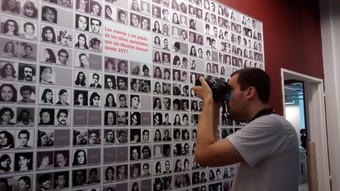
Photos of the “disappeared”
Collections of photos from families whose children and grandchildren had disappeared.
Background
The military, supported by a
significant number of the general populace involved in the Radical and
Socialist parties, opposed Juan Peron’s populist government and attempted to
overthrow his regime once in 1951 and twice in 1955 before finally succeeding on a third attempt in 1955 during the Revolucion Libertadora. After taking
control, Peronism was outlawed. Peronists began organizing a resistance
movement centered around workplaces and trade unions, and the working classes
sought economic and social improvements. Over time, as democratic rule was
partially restored and promises to allow freedom of expression and other
political liberties to Peronists was not respected, resistance groups
militarized, forming guerrilla groups.
Jorge Ricardo Masetti, the leader
of the Guevarist People’s Guerrilla Army (EGP) that infiltrated Bolivia’s army in 1964, is considered by some to be Argentina’s first disappeared person. Prior to
1973, the major revolutionary groups within Argentina were the Peronist Armed
Forces (FAP), the Marxist-Leninist-Peronist Revolutionary Armed Forces (FAR),
and the Marxist-Leninist Armed Forces of Liberation (FAL). Over time, many of
these guerrilla forces combined or were effectively eradicated by the
government. For example, FAR joined the Montoneros, formerly an urban group of
intellectuals and students, and FAP and FAL were absorbed into the Marxist
People’s Revolutionary Army (ERP). Meanwhile, the EGP and the Peronist
Uturuncos were small enough to be overcome by government forces and ceased to
exist.
A Decade of Violence
By the early 1970s, the
consolidated guerrilla groups that remained were kidnapping and assassinating
high-ranking military and police officers almost weekly. The extreme left
bombed and destroyed numerous military and police buildings in its campaign
against the government, but unfortunately a number of civilian
and non-governmental buildings were targeted as well. For instance, the
Sheraton Hotel in Buenos Aires was bombed in 1972, killing a woman and injuring
her husband. A crowded theater in downtown Buenos Aires was also bombed in
1975. In 1978, a powerful bomb meant to kill an Argentine admiral ripped
through a nine-story apartment building, killing three civilians and trapping many
others under the debris.
In 1973, as Juan Peron
returned from exile, the Ezeiza massacre marked the end of an alliance between
left- and right-wing factions of Peronism. In the subsequent year, Peron
withdrew his support of the Montoneros shortly before his death. During the presidency
of his widow Isabel Martinez de Peron, the far-right paramilitary death squad
Triple A emerged, increasing armed struggles. In 1975, Isabel signed a number
of decrees empowering the military and the police to step up efforts to destroy
left-wing subversion, particularly the ERP. Isabel was ousted from power the
subsequent year, 1976, by a military coup.
U.S. Involvement
In August 2016, the U.S. State
Department released 1,080 pages of declassified State Department documents that
revealed a growing hostility between the administration of US President Jimmy
Carter and the 1976 junta that overthrew Isabel. Carter took issue in
particular with Argentina’s growing list of human rights violations, although
the previous administration under Gerald Ford was strongly sympathetic to
the junta, with Secretary of State Henry Kissinger even advising Argentina’s
Foreign Minister, Cesar Guzzetti, to carry out anti-Communist policies before
Congress was back in session. Despite this, there is no documentation suggesting
that the U.S. government had direct involvement or knowledge of the developments
leading up to or following the coup that ousted Isabel.
The National Reorganization
Process
The juntas, led by Jorge
Rafael Videla until 1981 and subsequently by Roberto Viola and Leopoldo
Galtieri until 1983, organized and carried out strong repression of political
dissidents via the government’s military and security forces, which they
referred to as their National Reorganization Process. They were responsible for
illegal arrests, torture, killings, and the forced disappearance of an
estimated 9,000 to 30,000 people. Assassinations occurred via mass shootings
and throwing live citizens from airplanes to their death in the ocean
below. Additionally, 12,000 prisoners, many of whom had not been convicted via
any legal processes, were detained in a network of 340 secret concentration
camps located throughout Argentina. The government coordinated actions with
other South American dictatorships as well.
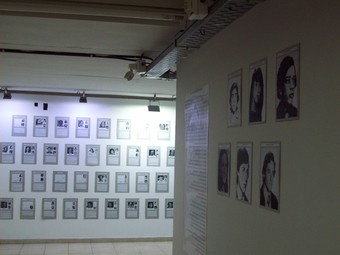
Memorial to the disappeared
Photographs of victims of the 1976-83 dictatorship.
Faced with increasing public opposition and severe economic problems, the
military tried to regain popularity by occupying the disputed Falkland Islands.
It suffered a lopsided defeat against Great Britain, which was in possession of
the territories, during the subsequent Falklands War, and was forced to resign
governing powers in disgrace, paving the way for the restoration of Argentinian
democracy.
36.2.5: Alfonsín’s Presidency
Although Alfonsín began his administration well-liked due to his prosecution of war crimes and consolidation of Argentina’s
democratic institutions, his inability to prevent worsening economic crises
caused his popularity to decline.
Learning Objective
Detail why Alfonsín was so unpopular by the end
of his presidency
Key Points
- Raul Ricardo
Alfonsín Foulkes was an Argentine lawyer, politician, and statesman who served
as the President of Argentina from December 10, 1983, until July 8, 1989. - Three days after
assuming the office of president, Alfonsín sent a bill to Congress revoking the
self-amnesty law established by the military. The Trial of the Juntas began at
the Supreme Court in April 1985 and was the first time the leaders of a
military coup were put on trial in Argentina. - Alfonsín’s first
priority while in office was to consolidate democracy in the country,
incorporate the armed forces into their standard role within a civilian
government, and prevent further military coups. -
Labor unions
were still controlled by Peronist elements, and Alfonsín sought to reduce their
influence, fearing they may become destabilizing forces for the fledgling
democracy. - Alfonsín began
his term with many economic problems. Argentina’s foreign debt was nearly $43
billion by the end of 1983, and the country narrowly prevented a
sovereign default in 1982. -
The Austral plan
froze prices and wages, choking inflation for some time; put a temporary hold
on the printing of paper money; arranged for spending cuts; and established a
new currency, the Austral. However, inflation rose again by the end of 1985,
the CGT opposed the wage freeze, and the business community opposed the price
freeze. -
In 1987,
Alfonsín’s government attempted new measures to improve the state of
Argentina’s economy, increasing taxes and privatizations while decreasing
spending. However, many measures could not be effectively enforced, and the
government lost the 1987 midterm elections as well as the general elections of
1989.
Key Terms
- hyperinflation
-
In economics, when a country experiences very
high and accelerating rates of inflation, which erodes the real value of local
currency and causes the population to minimize their holdings of said money. - command
responsibility -
Sometimes referred to as superior
responsibility, the legal doctrine of hierarchical accountability in cases of
war crimes.
Raul Ricardo Alfonsin
Foulkes was an Argentine lawyer, politician, and statesman who served as the
President of Argentina from December 10, 1983 until July 8, 1989. He was
elected a deputy in the legislature of the Buenos Aires province in 1958 during the presidency of Arturo Frondizi and a national deputy during the presidency
of Arturo Umberto Illia. He opposed both sides of the Dirty War and filed
several writs of Habeas corpus,
requesting the freedom of victims of forced disappearances during the National
Reorganization Process. He denounced the crimes of the military dictatorships
of other countries and opposed actions of both sides of the Falklands War. He
became the leader of the Radical Civil Union (UCR) following Ricardo Balbin’s
death and was the Radical candidate for president during the 1983 elections,
which he won.
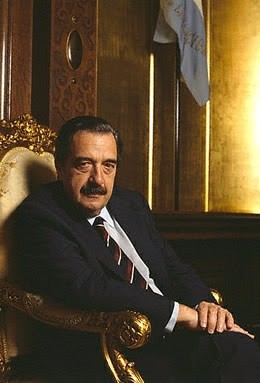
Alfonsin’s Official Presidential Portrait, 1984
Alfonsin’s presidential
inauguration was attended by Isabel Peron in a sign of support, despite
internal recriminations regarding the Peronist defeat. Left-wing terrorism had
been neutralized by this time, but both parties were eager to prevent the
return of military rule, and there were factions within the military
eager to reinstate an authoritarian government. Three days after assuming the
office of president, Alfonsin sent a bill to Congress to revoke the
self-amnesty law established by the military, as he had promised to do while on
the campaign trail. He also ordered the initiation of judicial cases against guerrilla
and military leaders, as well as the extradition of guerrilla leaders living
abroad. These acts were well-received by groups such as the Mothers of the
Plaza de Mayo that were seeking reparations for the actions of the military
during the Dirty War.
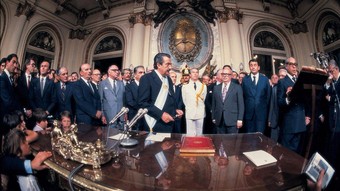
Raúl Alfonsín’s presidential inauguration, 1983
Alfonsin assumed the presidency after the darkest period of dictatorial rule in Argentina’s modern history.
Prosecution of the Military
The Trial of the Juntas
began at the Supreme Court in April 1985 and lasted the remainder of the year.
It was the first time the leaders of a military coup were put on trial in
Argentina. In December, the tribunal handed down life sentences for Jorge
Videla and former Navy Chief Emilio Massera, as well as a 17-year sentence for
Roberto Eduardo Viola. The trials were followed by bomb attacks and rumors of
military protests and coups. In order to appease the military, Alfonsin
proposed the full stop law, which set a deadline for Dirty War-related
prosecutions. The Congress approved the law despite strong public opposition.
Prosecutors rushed to start cases before the deadline, filing 487 charges
against 300 officers, 100 of whom were still in active service.
Two officers refused to
appear in court, starting mutinies in Cordoba and Campo de Mayo. The rebels
were referred to as Carapintadas, which is Spanish for “painted faces”, a
reference to their use of military camouflage. The General Confederation of
Labor (CGT) called a general strike in support of Alfonsin, and large masses
rallied in the Plaza de Mayo to support the government. Alfonsin negotiated
directly with the rebels and secured their surrender. However, the timing was
exploited by the military and opposition
parties, and they painted the outcome as a surrender by Alfonsin.
Alfonsin’s first priority
while in office was to consolidate democracy in the country, incorporate the
armed forces into their standard role within a civilian government, and prevent
further military coups. He used budget and personnel cuts to attempt to reduce the political
power of the military. Despite the revocation of
self-amnesty and prosecution of senior officers, Alfonsin was willing to dismiss
charges against lower-ranking military personnel under the principle of command
responsibility. He also created the National Commission on the Disappearance of
Persons (CONADEP), composed of several well-known personalities, to document cases
of forced disappearances, human rights violations, and abduction of children.
In its “Nunca mas” report, the CONADEP revealed the wide scope of crimes
committed during the Dirty War and how the Supreme Council of the military supported the military’s actions against guerrillas.
Relationship with Unions
Labor unions were still
controlled by Peronist elements, and Alfonsin sought to reduce their influence,
fearing they would become destabilizing forces for the fledgling democracy. He
rejected their custom of holding single-candidacy internal elections and felt
union administrations were totalitarian rather than a genuine reflection of
the demands of the workforce. He proposed changing the laws by which those
internal elections abided and removing union leaders appointed during the
military juntas. The CGT rejected the proposal, claiming it was too
interventionist, and prompted Peronist politicians to vote against it. The law
was approved by the Chamber of Deputies, but failed to pass in the senate by
one vote. A second bill was proposed that simply called for new internal
elections, without changing the laws by which they abided, and that bill was
approved. As a result, the labor unions remained largely Peronist.
Alfonsin made use of a
regulation established during the junta that allowed the president to regulate
the level of wages, and authorized wage increases every 3 months to keep up
with inflation. The CGT rejected this and proposed instead that wages should be
determined by free negotiations. Alfonsin allowed strike actions, forbidden during the junta, which also allowed the unions to expand their
influence. There were 13 general strikes and thousands of minor labor conflicts
during his administration. Conflicts centered around high inflation, and the
unions remained supportive of the president in the face of military rebellions
and despite political differences.
Economic Policy
Alfonsin began his term with
many economic problems. Argentina’s foreign debt was nearly 43 billion dollars
by the end of 1983, and the country narrowly prevented a sovereign default
in 1982. During that year, GDP fell by 5.6% and manufacturing profits fell by
55%. Unemployment was around ten percent and inflation was nearly 209%. It also
seemed unlikely the country would received badly needed foreign investment.
Many possible solutions, such
as devaluation of the currency, privatization of industry, or restrictions on
imports, would have proven unpopular. Instead, Bernardo Grinspun, the first
minister of the economy, arranged to increase wages, which caused inflation to
decrease significantly. Negotiations were also entered to obtain more favorable
terms on the country’s foreign debt, but those were unsuccessful. Grinspun
resigned in March 1985 when debt reached $1 billion. He was succeeded by Juan
Vital Sourrouille, who developed the Austral plan. This plan was a success in
the short term. It froze prices and wages, choking inflation for some time; put
a temporary hold on the printing of paper money; arranged for spending cuts,
and established a new currency, the Austral. However, inflation rose again by
the end of 1985, the CGT opposed the wage freeze, and the business community
opposed the price freeze.
With the support of the
World Bank, Alfonsin’s government attempted new measures to improve the state
of Argentina’s economy in 1987. The government increased taxes and privatizations
and decreased spending. However, many of these measures could not be
effectively enforced, and the government lost the 1987 midterm elections. Many
of the large unions that previously supported the government attempted to distance
themselves from it, and the business community was unable to suggest a clear
course of action to resolve the crisis that was unraveling. A “spring plan” was
proposed to keep the economy stable until general elections took place in 1989.
The plan consisted of freezing prices and wages as well as reducing the
federal deficit and received even worse public reception than the Austral
plan, with no political parties fully endorsing it. Meanwhile, the World Bank
and IMF refused to extend credit to Argentina, and many big exporters refused
to sell dollars to their central bank, depleting reserves. The austral was
devalued in February 1989 and the already high inflation evolved into hyperinflation. As a result, Alfonsin’s government
lost the general election to Peronist Carlos Menem.
36.3: Chile
36.3.1: Chile’s Presidential Era
The
early years of Chile’s Presidential Era were dominated by two political
figures: Arturo Alessandri Palma and Carlos Ibanez del Campo.
Learning Objective
Define
the “Presidential Era” in Chile
Key Points
- On January 23, 1925, the Chilean military
overthrew the September Junta in a coup d’etat. - On March 20, 1925, Arturo Alessandri Palma,
former president of Chile, returned from exile and drafted a new constitution,
which was put in effect on September 18, 1925. - The new constitution reinforced presidential
powers over the legislature. - Alessandri’s government was composed of left-wing
and radical groups, but many began to distance themselves from
the President after he took power. - Alessandri began encountering internal
opposition from his own Minister of Defense, Colonel Carlos Ibanez del Campo,
after the government repressed a number of demonstrations, leading to massacres.
Alessandri resigned, and after a short interim period, Ibanez won the
presidency. - Ibanez’s cabinet remained popular until the
outbreak of the Great Depression in 1931 as a result of a high rate of economic
growth fueled by American loans. - Once the effects of the economic crisis began to
reach Chile, political unrest abounded and Ibanez resigned on July 26, 1931.
Key Terms
- Presidential Era
-
The
period in Chilean history from the adoption of the 1925 constitution to the
fall of the Popular Unity government on September 11, 1973. - trade barriers
-
Government-induced
restrictions on international trade, usually involving some sort of cost on
trade that raises the price of traded products.
The Presidential Era is the period in Chilean history from
the adoption of the constitution on September 18, 1925, to the fall of the
Popular Unity government headed by President Salvador Allende on September 11,
1973. It coincides with what is known as the “development inwards” period in
Chilean economic history.
Arturo Alessandri Palma and a New Constitution
On January 23, 1925, the Chilean military
overthrew the September Junta in a coup d’etat. They handed power over to
General Pedro Dartnell as interim president, but Dartnell formed another junta,
the January Junta, during his time in power. On March 20, 1925, Arturo
Alessandri Palma, former president of Chile, returned from exile, ending the
January Junta. Alessandri drafted a new constitution, which was approved by
plebiscite on August 30 and put into effect on September 18. The new
constitution reinforced presidential powers over the legislature. Alessandri
also created a Central Bank, breaking from Chile’s adherence to classically
liberal economic policies.
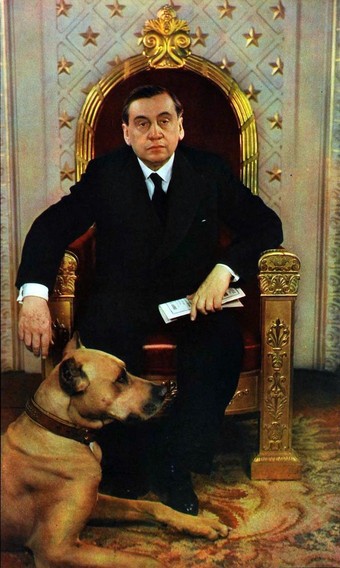
Alessandri with his Great Dane, Ulk (1932)
Alessandri’s government was composed of a coalition of
left-wing and radical groups, but many of these groups began to distance
themselves from the President after he took power. Alessandri’s government
repressed demonstrations, leading to notable massacres such as Marusia and La
Coruna. As a result, Alessandri began encountering internal opposition from his
own Minister of Defense, Colonel Carlos Ibanez del Campo, who had a popular
following. Ibanez lent his support to a manifesto drafted across various
political parties calling for Ibanez to run as an official candidate for
president. As a result, Alessandri resigned.
Ibanez was prompted to find a candidate that all parties
could agree upon. Emiliano Figueroa Larrain from the Liberal Democratic Party
was chosen and elected in October 1925 with nearly 72% of the vote. Ibanez was
designated the Minister of the Interior in February 1927, meaning he would become vice president in the case of a
vacancy in the presidency.
Ibanez convinced President Figueroa to resign two months later, took his place
as vice president, and called for elections, which took place in May 1927.
Ibanez overwhelmingly won the presidency with 98% of the vote.
Carlos Ibanez (1827-1931)
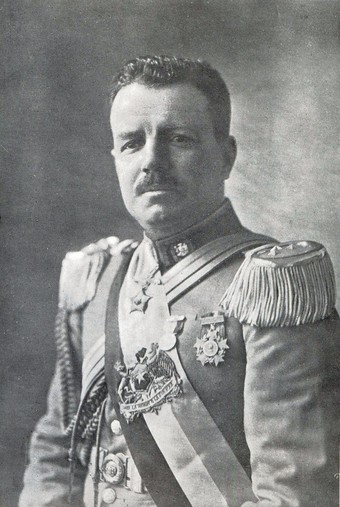
Carlos Ibanez del Campo (1927)
Ibanez’s cabinet remained popular until the outbreak of the
Great Depression in 1931. As president, Ibanez exercised dictatorial powers and
enjoyed being compared to Benito Mussolini. Early in Ibanez’s
administration, Congress and various political parties did not protest against
his increasingly dictatorial leanings. In fact, Ibanez was granted decretos con fuerza de ley (or decrees
having forces of law) within a democratic framework. He suspended parliamentary
elections, naming politicians to the Senate and Chamber of Deputies himself.
Freedom of press was restricted with 200 politicians arrested or exiled,
including former president Alessandri. The Communist Party was proscribed and
the workers’ movement was strongly repressed.
Ibanez’s popularity drew heavily from American loans, which
helped promote a high rate of growth throughout the country. Using these funds,
Ibanez launched important public works, including the construction of canals,
bridges, prisons, ports, and restoration of the facade of the presidential palace
as well as the secondary presidential residence at Castillo Hill. His
popularity survived the Wall Street crash of 1929, the effects of which were felt in Chile by the end of 1930. In 1930, prices of saltpeter and
copper, on which the Chilean economy was strongly dependent, abruptly fell, at
which point all loans were halted and called. Without an influx of foreign
currency and with the U.S. and European implementation of high tariffs and
return to protectionism, the Chilean economy began to suffer. Unemployment in
northern mines affected tens of thousands of people. In 1931, the influx of
international credit into Chile also ended, pushing the state to the edge of
bankruptcy.
Although Ibanez’s government increased export
taxes to 71% and established trade barriers, he did not manage to make balance
of trade more equitable for Chile, which led to a depletion of gold reserves.
With the economic situation showing no sign of improvement, the exiled Alessandri
began to plan a comeback and a number of conspiracies were undertaken to oust
Ibanez from power, although they all proved unsuccessful. Public unrest
abounded. Students at the University of Chile and the Pontificia Universidad
Catolica de Chile initiated demonstrations. Physicians and lawyer groups also
joined in public demonstrations. In the midst of all the demonstrations, police
forces killed more than 10 people, and as a result, Ibanez was forced to resign
on July 26, 1931. Juan Esteban Montero, a member of the Radical Party, was
proclaimed president by Congress after Ibanez’s designated replacement also
resigned.
36.3.2: Instability and Coups
The various coups that rocked Chile increased
political divisiveness and instability throughout the country.
Learning Objective
Explain the effect of the various coups that
rocked Chile.
Key Points
- Shortly after
President Juan Montero’s inauguration in December 1931, revolutionaries took
control of some military ships and sunk them in the Bay of Coquimbo in what
became known as the Escuadra uprising. -
Shortly
thereafter, on June 4, 1932, planes from El Bosque Air Base flew over La
Moneda, the presidential palace, causing Montero’s government to resign,
leading to the proclamation of a socialist republic. - After a period
of political instability under the socialist republic, during which time leadership
of the country exchanged hands frequently, the Radical Party came to power in
1938. - Internal discord within the Radical Party and associated coalitions eventually
led to the re-election of General Carlos Ibanez as an independent candidate.
Key Terms
- import substitution
industrialization -
A trade and economic policy that advocates
replacing foreign imports with domestic production. - Ibanistas
-
A movement aimed at creating a dictatorship
under General Carlos Ibanez during his presidency in the mid-1950s, consisting
mainly of young army officers. It was inspired in large part by Argentinian
President Juan Domingo Peron’s rise to power. - Ariostazo
-
A brief revolt that occurred on August 25, 1939,
led by General Ariosto Herrera, in what turned out to be a non-violent attempt
against the government of Chilean President Pedro Aguirre Cerda.
Shortly after President Juan
Montero’s inauguration in December 1931, revolutionaries took control of some
military ships and sunk them in the Bay of Coquimbo in what became known as the
Escuadra uprising. Although the uprising was peacefully resolved, the string of
events demonstrated to the public how fragile the new government was. Shortly
thereafter, on June 4, 1932, planes from El Bosque Air Base flew over La
Moneda, the presidential palace, causing Montero’s government to resign rather
than call upon the army to put down the coup. That same night, the victorious
revolutionaries, including Marmaduque Grove, Carlos Davila, and Eugenio Matte,
proclaimed the Socialist Republic of Chile.
The Socialist Republic
(1931-1932)
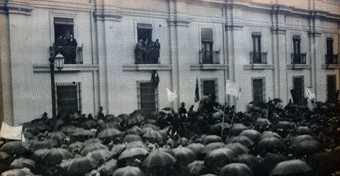
Socialist Republic March
March in support of the proclamation of the Socialist Republic of Chile, in front of La Moneda Palace (June 12, 1932). Source: El Nuevo Sucesos.
The proclamation of a
socialist republic took the country by surprise and divided public opinion
immediately. The Communist Party of Chile (PCCh) and many trade unions opposed
the Republic because they believed it to be militarist. The business community
and many students also heatedly opposed the new political entity on ideological
grounds. Ultimately, the new republic only received the guarded support of
other socialists and some employees’ associations.
A few days following the
establishment of the new republic, the junta dissolved Congress and, among
other measures, stopped evictions from low-rental properties, decreed a
three-day bank holiday, placed strict limits on bank withdrawals, and ordered
the Caja de Credito Popular, a savings and loan bank for Chileans of modest
means, to return pawned materials. Half-a-million free meals were ordered to be
served daily to Chile’s unemployed. The government quickly ran short of funds,
however, and ordered the police to raid all jewelry shops in Santiago,
providing jewelers receipts that could be used to cash in for paper pesos by
means of compensation in order to avoid the act being termed a confiscation.
Credits and deposits in foreign currency in national and foreign banks
operating within the country were also declared property of the state.
Meanwhile, a General Commissariat of Subsistence and Prices was also
established with the authority to fix the price of staple foods.
Within the junta,
differences of opinion began to sharpen. Followers of General Ibanez opposed
the radicalization of the socialist movement, which was headed by Marmaduque
Grove and Eugenio Matte. On June 13, 1932, Carlos Davila resigned in protest,
and three days later on June 16, he expelled the socialist members of
government and replaced them with his own supporters with the support of the
army. Grove and Matte were arrested and exiled to Easter Island and Davila
proclaimed himself provisional president of the socialist republic. He also
declared a state of emergency, press censorship, and a number of
centrally-planned economic measures.
However, Davila did not have
enough support from the public or the military to remain in his position
indefinitely, and he was forced to resign on September 13, 1932. The presidency
then passed on to General Bartolome Blanche, who was subsequently replaced due
to the threat of a military uprising by President of the Supreme Court Abraham
Oyanedel. Oyanedel immediately called for presidential and congressional
elections. Tired of political instability, the Chilean people voted
center-right candidate and former president Arturo Alessandri into office.
Alessandri relied upon republican forces during the first four years of his
presidency to repress revolts and asked Congress on several occasions to
declare a state of emergency in order to act against perceived insubordination
before it could turn violent. These precautions were not unwarranted either,
with the rise of the Nazi-inspired National Socialist Movement of Chile and a
number of rural rebellions occurring.
Meanwhile, economic recovery
in the wake of the Great Depression was under way. Treasury Minister Gustavo
Ross, a pragmatic liberal, balanced the fiscal deficit with new taxes and
resumed payments of external debts. When a surplus was achieved, public works
became the new focus of the government, and projects like the construction of
the National Stadium in Santiago began.
The Radical Governments
(1938-1952)
The Radical Party of Chile was
founded during the mid-19th century based upon the principles of the
1789 French Revolution, upholding values of liberty, equality, solidarity,
participation, and well-being. It finally succeeded in achieving power from
1938 to 1952 due to the Popular Front left-wing coalition, although its
cabinets were haunted by ongoing parliamentary instability. The first Radical
President, Pedro Aguirre Cerda, was a teacher and lawyer from University of
Chile. He was elected in 1938 as a candidate from the Popular Front, narrowly
defeating conservative Gustavo Ross due to the political backlash caused by the
Seguro Obrero massacre, which followed an attempted coup d’etat by the National
Socialist Movement of Chile.
Cerda promoted the development
of technical-industrial schools as a means of promoting the industrialization
of the country and created thousands of new primary, secondary, and higher
education schools. Following a devastating earthquake that hit Chile on January
24, 1939, Cerda’s cabinet created the Corporacion de Fomento de la Produccion
(CORFO) to encourage an ambitious program of import substitution
industrialization. During this time, the Empresa Nacional del Petoleo (ENAP)
state oil company was created, as well as a state electricity company, steel
holding,and sugar company. He faced military opposition to his plans,
particularly in the first year of his presidency. Opposition boiled over with
the Ariostazo in August 1939, an attempted putsch led by General Ariosto Herera
and General Carlos Ibanez del Campo. General Herera had been strongly
influenced by Italian fascism.
The German-Soviet Non
Aggression Pact of 1939 led to a dismantling of left-wing coalitions and the
Comintern denounced the Popular Front strategy. However, following the German
invasion of the Soviet Union in 1941, the Chilean Communist Party joined the
government again and the left-wings’ coalition remained intact following
Cerda’s resignation and death. An election was held in February 1942 and Juan
Antonio Rios, a member of the conservative wing of the Radical Party, won with
55.7% of the votes. Rios’ presidency was marked by parliamentary instability
and rivalries among cabinet members who held different political stances. The
Chilean Communist Party opposed Rios on the grounds that he chose neutrality in
the Second World War and refused to break off diplomatic relations with Axis
Powers. Meanwhile, members of the right-wing accused him of complacency in
dealing with left-wing infractions. The Chilean Socialist Party accused Rios of
going too easy on large firms and criticized his refusal to pass labor
legislation protecting workers.
The Radical Party itself
touted policy in 1944 that Rios found unacceptable. Their propositions included
an end to relations with Francoist Spain, political recognition of the USSR,
and stacking Rios’ cabinet with Radical members. Rios had already been forced
via economic and diplomatic pressure to break off relations with Axis Powers in
1943, which made Chile eligible for the U.S. Lend-Lease program, aiding in
economic recovery. Unfortunately, the close relations with the United States that this
entailed created further problems for Rios at home, and his continued refusal
to implement Radical Party policies caused the entirety of his cabinet to
resign, effectively leaving the President without a party. As a result, the
Radical Party lost a number of parliamentary seats in the legislative elections
of 1945, and the right-wing gained in congressional representation. Faced with a
diagnosis of terminal cancer and unrest at home, Rios gave up his presidential
powers in January 1946, and for the second time in five years, a presidential
election was held on September 4, 1946.
Left-wing Radical Party
candidate Gabriel Gonzalez Videla won the September 1946 election, this time
with the Radical Party allying itself with the Communist Party instead of the
Democratic Alliance. However, because Gonzalez only received 40% of the votes,
Congress had to confirm his appointment, which led to various party
negotiations and the creation of a composite cabinet of liberals, radicals, and
communists. Once in office, Gonzalez had a fall out with the communists when he
refused to grant them more cabinet seats following their success in municipal
elections. The Liberal Party, meanwhile, threatened by the successes of the
Communist Party, withdrew from the cabinet. Eventually, due to pressure from
the United States, President Gonzalez enacted a Law of Permanent Defense of the
Democracy, which outlawed the Communist Party and banned more than 20,000
people from electoral lists. These actions gleaned new supporters for
Gonzalez’s government from among conservatives and liberals.
Detention centers were
re-opened and used to jail communists, anarchists, and other revolutionaries,
though no detainee was executed during this period. Many prominent communists,
such as Senator Pablo Neruda, fled into exile, and a number of pro-communist
strikes and demonstrations were suppressed. In fact, a number of strikes in the
sectors of public transportation and mining throughout the year 1947 prompted
Gonzalez to make increasing use of emergency laws, which in turn led to further
protest demonstrations. On the far right of the spectrum, the pig trotters’
conspiracy attempted a military coup to
bring Carlos Ibanez back to power. The coup was unsuccessful and an
investigation was ordered on the coup leaders, leading to many arrests. Ibanez
himself was absolved of all responsibility, however.
In the parliamentary
elections of 1949, pro-government parties triumphed, however, the unity between
right-wing parties and radicals and socialists did not last long. Radicals were
unhappy with the economic policies of the right-wing finance minister Jorge
Alessandri, though they were moderately successful in controlling inflation.
When a protest by government employees erupted in 1950, radicals immediately
sided with the protesters and right-wingers resigned en masse from Gonzalez’s
cabinet. As a result, Gonzalez lost the pro-government majority in Congress and
was unable to achieve much policy-wise thereafter. Nonetheless, he remained a
champion for women’s rights, installing the first woman cabinet minister, the
first woman ambassador, and creating the Oficina de la Mujer.
The Birth of Mass Politics
(1952-1964)
Due to the protectionist
policies of the radical governments and their predecessors, Chile had developed
a strong, national industry, which led to a renewal of the economic and social
structure of the country. For the first time in its history, agriculture ceased
being the primary productive sector, and mining and the service sector became
increasingly important to the national economy. At the same time, Chile’s
political climate was becoming increasingly divided. The 1952 presidential
election was carved up among many competing parties, including conservatives,
liberals, socialists, radicals, and an emerging centrist Christian Democrat
Party, which had support from a large specter of personalities. Additionally,
for the first time in Chile’s history, women’s suffrage was legalized.
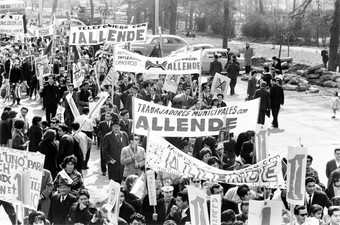
Allende supporters
A crowd of people marching to support the election of Salvador Allende for president in Santiago, Chile.
Four candidates stood up in
the 1952 election. Arturo Matte was the centrist candidate presented by the
Conservative and Liberal parties; Salvador Allende served as the Socialist
Party’s candidate in his first candidacy to the presidency; the Radical Party
supported Pedro Enrique Alfonso; and General Carlos Ibanez ran for the office
as an independent. Ibanez campaigned on a platform of eliminating political
corruption, but remained vague in his proposals and provided no clear position
as to his position within the political spectrum. He won the election on
September 5, 1952, with 46.8% of the popular vote. Ibanez’s election was
ratified by Congress and he took office on December 4.
Once in office, Ibanez
focused on rallying his supporters to win a majority in the 1953 legislative
elections. His supporters consisted of the right-wing Partido Agrario Laborista
(PAL) and dissidents within the Socialist Party, which had formed the Popular
Socialist Party. Some feminist political unions also lent their support to
Ibanez. Many such supporters stacked Ibanez’s initial cabinet, which despite
its internal fragility, helped to win some seats in the 1953 elections.
Nonetheless, Ibanez remained at the mercy of an unified opposition during his
tenure as president.
Ibanez left much of the
governing during his second term to his cabinet, and indeed his second term
progressed as a modest political success. Ibanez won the support of many
left-wingers by repealing the Ley de Defensa de la Democracia (Law for the
Defense of Democracy), which had banned the Communist Party. However, in 1954,
a copper mine strike spread across the country, and Ibanez proclaimed a state
of siege in response. Congress immediately opposed this executive measure and
put an end to it. Ibanez also froze wages and prices in order to put an end to
the chronic inflation of the Chilean economy. Unfortunately, these same
policies stopped growth and inflation continued to skyrocket, leading to
relative civil unrest.
A movement of Ibanistas, consisting mainly of young army officers and
inspired by the movement surrounding Argentine President Juan Domingo Peron,
formed groups aimed at creating a new dictatorship under Ibanez. Controversy
erupted when the public learned that Ibanez met with these conspirators.
Additionally, Ibanez’s hostility towards the Federacion de Estudiantes de la
Universidad de Chile student trade union led to outbreaks of violence during
demonstrations. As a result, PAL withdrew itself from Ibanez’s government,
leaving him isolated. Meanwhile, the Radicals, Socialists, and Communists
organized the Frente de Accion Popular (Front for Popular Action) and
concentrated their efforts around presidential candidate Salvador Allende.
36.3.3: Allende and Popular Unity
The United States was distrustful of Chile’s
President Salvador Allende due to his Marxist beliefs and policies, leading to
a military coup ousting Allende from power that was strongly encouraged by the
CIA.
Learning Objective
Evaluate why the United States was distrustful
of Allende’s policies
Key Points
- Salvador Allende
was the president of Chile from 1970 until 1973 as well as the head of the
Popular Unity government. He was the first Marxist to be elected to the
national presidency of a democratic country. - There was an
active campaign against Allende’s presidential confirmation within Chile’s Congress,
including clandestine efforts to prevent Allende from being
inaugurated. In the end, his presidency was only ratified once he signed a
Statute of Constitutional Guarantees. - While in office,
Allende pursued a policy he called “La via chilena al socialismo”, or “the
Chilean way to socialism”, which included nationalization of certain
large-scale industries such as copper and healthcare, land redistribution, the
continuation of the educational policies of his predecessor Eduardo Frei
Montalva, and a program guaranteeing free milk for children. - The Popular
Unity coalition was not perfectly united around Allende’s platform due to the
president’s more moderate leanings and commitment to the principles of
democracy. - During his first
year in office, Allende’s government achieved economic growth, reductions in
inflation and unemployment, redistribution of income, and increases in
consumption. - Despite his
predecessor’s deepening of Chile’s relations with the USSR, Allende attempted
to maintain normal relations with the United States. However, after the United States cut
off credits and increased its support to Allende’s opposition, the government
was forced to seek alternative sources of trade and finance from the USSR. - The U.S. government
encouraged Allende’s resignation, overthrow, or electoral defeat due to a fear
of .Marxism and dissatisfaction with the nationalization of U.S copper concerns
within Chile. - On August 22, 1973,
the Christian Democrats and the National Party members of the Chamber of
Deputies voted 81 to 47 in favor of a resolution that asked the authorities
to preserve Chilean democracy in face of the threat Allende’s government
presented. - Two days later, Allende responded point-by point to the accusations and accused
Congress in return of encouraging sedition, civil war, and even a coup. - The Chilean military seized the opportunity created by the Chamber of
Deputies’ August 22nd Resolution to oust Allende on September 11, 1973.
As the Presidential Palace was surrounded and bombed, Allende committed
suicide.
Salvador Allende was the
president of Chile from 1970 until 1973 and the head of the Popular Unity
government. He was the first ever Marxist to be elected to the national
presidency of a democratic country. Although the 1970 Chilean presidential
election was lawful, the Chilean Senate declared the Allende government unlawful in August 1973 due to its practice of unconstitutional expropriation
of private property. Allende’s presidency was cut short by a military coup
shortly thereafter.
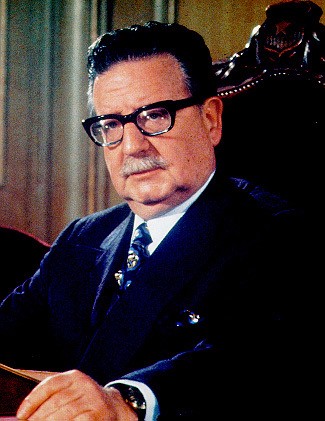
Salvador Allende Gossens
President of Chile from 1970 to 1973
Chilean Presidential
Election, 1970
Allende ran with the Popular
Unity coalition during the 1970 presidential election. Succeeding the FRAP
left-wing coalition, it was comprised primarily of leftist political parties,
including the Socialist Party, the Communist Party, the Radical Party, the
Party of the Radical Left (until 1972), the Social Democratic Party, MAPU, or
Movimient de Accion Popular Unitario, and the Christian Left, which joined the
coalition in 1971. Allende won a plurality of the popular vote at 36.2% with a
platform promising nationalization of the mineral industry as well as income
and land redistribution. Conservative former president Jorge Alessandri, the
candidate from the National Party, received slightly fewer votes, approximately 34.9%. According the Chilean constitution, Congress had to decide
between the two candidates with the most votes, and according to precedent,
Congress tended to choose the candidate with the largest number of votes.
However, there was an active
campaign against Allende’s confirmation within Congress at the
time, including clandestine efforts to prevent Allende from being
inaugurated. In the end, his presidency was only ratified once he signed a
Statute of Constitutional Guarantees, convincing the majority of Christian
Democratic senators who favored Alessandri of Allende’s allegiance to
democracy. Having signed this statute, members of the Christian Democratic
Party in the Senate were willing to vote in favor of granting the presidency to
Allende.
“The Chilean Way to Socialism”
While in office, Allende
pursued a policy he called “La via chilena al socialismo,” or “the Chilean way
to socialism,” which included nationalization of certain large-scale industries
such as copper and healthcare, land redistribution, the continuation of the
educational policies of his predecessor Eduardo Frei Montalva, and a program
guaranteeing free milk for children. Eduardo Frei’s government already
partially nationalized the copper industry by acquiring a 51% share in
foreign-owned mines, but copper remained the primary U.S. business in Chile
during this time. Early on, Congress supported Allende’s extensive vision for
government involvement in the economy, especially since the Popular Unity and
Christian Democratic parties combined had a clear majority in the legislature.
However, the government’s efforts to pursue these policies led to strong
outpouring of opposition from landowners, some middle class sectors,
financiers, the Roman Catholic Church, and the rightist National Party. Eventually,
the Christian Democrats united with the National Party in Congress as
opposition grew.
The Popular Unity coalition
itself was far from perfectly united around the platform of the president. Allende
himself was a more moderate representative of the Socialist Party and was
committed to the principles of democracy. He was supported by the Communist
Party, which, although less committed to the principles of representative
democracy, favored a cautious and gradual approach to the vast reforms that had
been proposed. By contrast, the radical left wing of the Socialist Party wanted
an immediate disruption to the existing capitalist system, even if it meant
resorting to violent means.
During his first year in
office, Allende’s government achieved economic growth, reductions in inflation
and unemployment, redistribution of income, and increases in consumption. The
government also significantly increased salaries and wages, reduced taxes, and
introduced free distribution of certain items deemed necessities. Groups
previously excluded from the state labor insurance scheme, such as the
self-employed or those employed by small businesses, were included for the
first time. Additionally, pensions were increased for widows, invalids,
orphans, and the elderly. The National Milk Plan provided more than 3 million
liters of milk per day in 1970, free of charge.
Foreign Relations
Soviet Union
Allende’s predecessor,
Eduardo Frei, had improved relations with the USSR, and in February 1970,
Frei’s government signed Chile’s first cultural and scientific agreement with
the Soviet Union. When Allende assumed the presidency, he attempted to maintain
normal relations with the United States. However, as a result of Chile’s nationalization
of the copper industry, the US cut off credits and increased its support to the
opposition. As a result, Allende’s government was forced to seek alternative
sources of trade and finance. Chile gained commitments from the USSR to invest
approximately $400 million in Chile over the course of the next six years,
though that number was smaller than the amount Allende hoped to receive. Trade between
the two countries did not significantly increase and mainly involved the
purchase of Soviet equipment. When Allende visited the USSR in late 1972 to request more aid and additional lines of credit, he was turned down.
In mid-1973, the USSR
approved the delivery of weaponry to the Chilean army. However, when news of an
attempted army coup to overthrow Allende reached Soviet officials, the shipment
was redirected to another country.
U.S. Opposition to Allende
U.S. opposition to Allende began several years
before he was elected President of Chile, but escalated once the prospect of a
second Marxist regime being established in the Western Hemisphere became more
likely (the first being Fidel Castro’s government in Cuba). The administration
of U.S. President Richard Nixon was already embroiled in the Vietnam War and the broader Cold War with the Soviet Union. The U.S. government intended to encourage Allende’s resignation, overthrow, or defeat by the
presidential election of 1976. To this end, the Nixon administration
clandestinely funded independent and non-state media and labor unions within
Chile and directed other governmental entities that no new bilateral economic
aid commitments should be undertaken with the government of Chile. The United States did however
provide humanitarian aid to Chile in addition to forgiving old loans valued at
$200 million from 1971 to 1972. The United States also did not invoke the Hickenlooper Amendment, which would have required an immediate
cut-off of U.S aid due to Allende’s nationalizations. Allende received new
sources of credit valued between $600 million and $950 million in
1972 and $547 million by June 1973. The International
Monetary Fund also loaned $100 million
to Chile during the Allende years.
The U.S. government used two tactics when countering Allende’s
government. “Track I” was a State Department initiative designed to
thwart Allende by subverting Chilean elected officials within the bounds of the
Chilean constitution. This tactic excluded the CIA. Track I expanded to
encompass a number of policies with the ultimate goal of creating conditions
that would encourage a coup. “Track II” was
a CIA operation overseen by Henry Kissinger and the CIA’s director of covert operations,
Thomas Karamessine. Track II excluded the State Department and Department of
Defense. The goal of Track II was to find and support Chilean military
officers who would engage in a coup.
Crisis
Congressional Resolutions
On August 22, 1973, the Christian Democrats and
the National Party members of the Chamber of Deputies voted 81 to 47 in favor
of a resolution that asked the authorities to preserve Chilean democracy
in face of the threat Allende’s government presented. They believed
Allende’s policies infringed upon the freedoms guaranteed by the Chilean constitution
and accused Allende of attempting to establish a totalitarian order upon the
country. Most accusations centered around a perceived disregard for the
separation of powers and the erosion of legislative and judicial prerogatives in
favor of granting these powers to the executive branch of government. Finally,
the resolution condemned the creation and development of government-protected armed
forces. President Allende’s efforts to reorganize the military and police
forces were characterized as nefarious attempts to use the armed and police
forces for partisan ends, destroy their institutional hierarchy, and
politically infiltrate their ranks.
Two days later on August 24,
1973, Allende responded point-by point to the accusations. He accused Congress
of encouraging sedition, civil war, and even a coup. He also pointed out that
the declaration failed to obtain the required two-thirds majority
constitutionally required to bring an accusation against the president and
argued that the legislature was trying to usurp the executive role.
1973 Chilean Coup D’etat
In early September 1973, Allende floated the idea of resolving the congressional
resolution crisis with a referendum. However, the Chilean military seized the opportunity
created by the Chamber of Deputies’ August 22nd Resolution to oust
Allende on September 11, 1973. As the Presidential Palace was surrounded and
bombed, Allende committed suicide.
A September 2000
report released by the CIA using declassified documents related to the military
coup found that the CIA had probably approved of and encour.aged the 1973 coup,
but there was no evidence that the U.S actually participated in it.
This
view has been challenged by some historians, such as Tim Weiner and Peter
Kornbluh, who have stated that the covert support of the United States was
crucial to the preparation for the coup, the coup itself, and the consolidation
of the regime afterward.
36.3.4: The Pinochet Years
Pinochet’s regime
represented a violent swing to authoritarianism following Allende’s Marxist administration.
Learning Objective
Contrast the Pinochet
regime with Allende’s before it
Key Terms
- military junta
-
An oligarchic form of
government that differs from a civilian dictatorship in a number of ways,
including motivations for seizing power, the institutions through which rule is
organized, and the ways in which leaders leave positions of power. Many
military juntas have viewed themselves as saving the nation from corrupt or
myopic civilian politicians. Military leaders often rule as a junta, selecting
one as the head. - disappeared
-
A person who is secretly
abducted or imprisoned by a state or political organization, or by a third
party with the authorization, support, or acquiescence of a state or political
organization. Following abduction, there is a refusal to acknowledge the
person’s fate or whereabouts, essentially placing the victim outside the
protection of the law.
Examples
- Augusto Jose Ramon
Pinochet Ugarte was President of Chile (1973- 1990) as well as
Commander-in-Chief of the Chilean Army (1973- 1998) and president of the
Government Junta of Chile (1973-1981). His rule of Chile is considered a
dictatorship. - According
to the Rettig and Valech Commissions,
the number of direct victims of human rights violations in Chile during the
government junta accounts for at least 35,000 people: 28,000 tortured, 2,279
executed, and 1,248 missing. In addition, some 200,000 people suffered exile
and an unknown number went through clandestine centers and illegal detention. - The government junta
formally banned socialist, Marxist, and other leftist parties that comprised
former President Salvador Allende’s Popular Unity coalition. -
On September 13, 1973,
the junta dissolved Congress and outlawed or suspended all political
activities, including suspension of the 1925 constitution. - Given
support from Pinochet, the United States., and international financial institutions, a
group of Chilean economists referred to as the Chicago Boys advocated
laissez-faire, free-market, neo-liberal, and fiscally conservative policies in
stark contrast to the extensive nationalization and centrally-planned economic
programs supported by Allende. - The
economic policies espoused by the Chicago Boys and implemented by the junta
initially caused several economic indicators to decline for Chile’s lower
classes, while financial conglomerates were major beneficiaries. - The United States maintained significantly friendlier
relations with Pinochet than it did with Allende.
Augusto Jose Ramon Pinochet Ugarte was the
President of Chile between 1973 and 1990 as well as Commander-in-Chief of the
Chilean Army from 1973 to 1998. He was also the president of the Government Junta
of Chile between 1973 and 1981. His rule of Chile is considered a dictatorship.
Pinochet assumed power in Chile following a U.S.-backed coup d’etat on September
11, 1973, which overthrew the democratically elected Popular Unity government
of President Salvador Allende and ended civilian rule. In December 1974, the
ruling military junta appointed Pinochet the Supreme Head of the Nation by
joint decree.
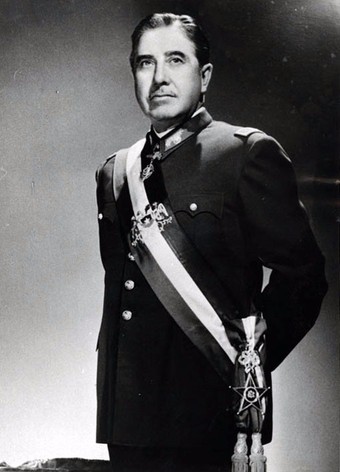
Official portrait of Augusto Pinochet
Circa 1974
Human Rights Violations
Human rights
violations during the military government of Chile refer to human
rights abuses, persecution of opponents, political repression, and state
terrorism committed by the Chilean armed forces and the police, government
agents, and civilians in the service of security agencies. According to the
Commission of Truth and Reconciliation (Rettig Commission) and the National
Commission on Political Imprisonment and Torture (Valech Commission), the
number of direct victims of human rights violations in Chile accounts for at
least 35,000 people: 28,000 tortured, 2,279 executed, and 1,248 missing. In
addition, some 200,000 people suffered exile and an unknown number went through
clandestine centers and illegal detention. The systematic human rights
violations committed by the military government of Chile under Pinochet
included gruesome acts of physical and sexual abuse as well as psychological
damage. From September 11, 1973, to March 11, 1990, Chilean armed forces, the
police, and those aligned with the military junta were involved in
institutionalizing fear and terror in Chile.
Political Suppression
Following its assumption of power in
1973, the government junta formally banned socialist, Marxist, and other
leftist parties that comprised former President Salvador Allende’s Popular
Unity coalition. On September 13, 1973, the junta dissolved Congress and
outlawed or suspended all political activities, including suspension of the
1925 constitution. Eduardo Frei, Allende’s predecessor as president, initially
supported the coup along with other Christian Democratic politicians. Later,
however, they assumed opposition roles to the military rulers, though by that
time many of them already lost much of their public influence. The Catholic Church, which first expressed its approval of military rule
over Allende’s Marxist government, was now led by Cardinal Raul
Silva Henriquez, one of the most outspoken critics of the regime’s social and
economic policies.
From 1974 to
1977, the DINA (National Intelligence Directorate) and other agencies such as
the Joint Command were the main institutions that committed acts of repression.
It was during this period that most forced disappearances took place. In DINA-established interrogation and detention camps, former members of
Allende’s Marxist government and Leftist movements like Movimiento de Izquierda
Revolucionario were incarcerated and brutally tortured. A large proportion of
the Chilean population was vulnerable to government surveillance.
Disappearances
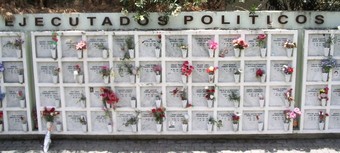
The Politically Executed
Funeral urns of political activists executed under the Chilean military regime (1973-1990) in a cemetery in Santiago.
“Disappearing
subversives” was a central instrument of state terror administered by the
Chilean military regime. According to the Rettig Report, 1,248 people were
“disappeared” by the Pinochet regime. This number remains a source of
contention, however, as hundreds of bodies have yet to be discovered. Many who disappeared
were neither given the chance to escape nor to become asylum seekers elsewhere,
and their bodies were deliberately hidden in undisclosed locations. Many people
were last seen in detention or torture centers run by intelligence agencies of
the military regime.
Following
General Pinochet’s arrest in 1998, Chile made a renewed effort to uncover the
atrocities of the past. For the first time in several decades, human rights
lawyers and members of the armed forces investigated where the bodies
of the disappeared were buried. On January 7, 2000, Chilean President Ricardo
Lagos made a 15-minute nationwide address, revealing that the armed forces had
uncovered information on the fate of approximately 180 people who had
disappeared. According to Lagos, the bodies of at least 150 of these people
were thrown into lakes, rivers, and the Pacific Ocean. The whereabouts of
hundreds of more bodies remain unknown.
Economy and
Free Market Reforms
After the
military took over the government in 1973, a period of dramatic economic
changes began. The Chilean economy was still faltering in the months following
the coup. As the military junta itself was not particularly skilled in
remedying the persistent economic difficulties, it appointed a group of Chilean
economists who were educated at the University of
Chicago. Given financial and ideological support from Pinochet, the United States, and
international financial institutions, the Chicago Boys advocated laissez-faire,
free-market, neo-liberal, and fiscally conservative policies in stark contrast
to the extensive nationalization and centrally-planned economic programs
supported by Allende. Chile was drastically transformed from an economy isolated
from the rest of the world with strong government intervention into a liberalized,
world-integrated economy where market forces were left free to guide most of
the economy’s decisions.
From an
economic point of view, the era can be divided into two periods. The first,
from 1973 to 1982, corresponds to the period when most of the reforms were
implemented. The period ended with the international debt crisis and the
collapse of the Chilean economy. Unemployment was extremely
high, above 20 percent, and a large proportion of the banking sector had become
bankrupt. The following period was characterized by new reforms and economic
recovery. Some economists argue that the recovery was due to a turnaround of
Pinochet’s free market policy; during this time he nationalized many of the
industries that were nationalized under Allende and fired the Chicago Boys
from their government posts.
Social Consequences
The economic
policies espoused by the Chicago Boys and implemented by the junta initially
caused several economic indicators to decline for Chile’s lower classes. Between
1970 and 1989, there were large cuts to incomes and social services. Wages
decreased by eight percent. Family allowances in 1989 were 28% of what they had
been in 1970 and budgets for education, health, and housing dropped more than 20% on
average. Massive increases in military spending and cuts in funding to public
services coincided with falling wages and steady rises in unemployment. The
junta relied on the middle class, huge foreign corporations, and foreign loans
to maintain itself.
Financial
conglomerates became major beneficiaries of the liberalized economy. Large
foreign banks reinstated the credit cycle, and international lending
organizations such as the World Bank, International Monetary Fund, and
Inter-American Development Bank also lent vast sums to Pinochet’s regime.
Additionally, many foreign multinational corporations such as International
Telephone and Telegraph (ITT), Dow Chemical, and Firestone, which was previously expropriated by Allende, returned to Chile.
Relationship
with the United States
Overall, the
United States maintained significantly friendlier relations with Pinochet than it did with
Allende. A document released by the U.S. Central Intelligence Agency (CIA) in
2000 titled “CIA Activities in Chile” revealed that the CIA actively supported
the military junta after the overthrow of Allende and made many of
Pinochet’s officers paid contacts of the CIA or U.S. military despite records
detailing human rights abuses. The United States provided substantial support to the
military regime between 1973 and 1979, although it criticized Chile in public. In
1976, the United States went beyond verbal condemnation of the regime and placed an
embargo on arms sales to Chile that remained in effect until the restoration of
democracy in 1989. Presumably, as international concerns grew surrounding
Chilean repression, the United States did not want to be seen as an accomplice to the
junta. Other prominent U.S. allies like the UK , France, and West Germany,
however, did not block arms sales to Pinochet and benefited from the lack of
American competition.
36.3.5: The Chilean Constitution of 1988
Due to pressure from big business, the
international community, and general unease with his rule, Pinochet was denied
a second eight-year term as president during the 1988 national plebiscite.
Learning Objective
Describe the circumstances of the 1988 national
plebiscite
Key Points
- Following the
September 11, 1973, coup d’etat, General Pinochet was designated president of
the newly established military junta government on what was supposed to be a
rotating basis with three other junta members. - Shortly
thereafter, the junta established an advisory committee and Pinochet staffed it
with his loyal Army officers. One of the first recommendations brought
forward by the committee was to do away with the idea of a rotating presidency. - On September 11,
1980, a constitutional referendum took place in which the new Chilean constitution
was approved by 67% of voters. - The new
constitution established a transition period of eight years during which
Pinochet would continue to exercise executive power. Before the end of that
period, a candidate for president was to be proposed and ratified by registered
voters in a national plebiscite. - On August 30,
1988, Pinochet was declared the presidential candidate, and on October 8, 1988,
Pinochet was denied a second eight-year term by 54.5% of the vote. - Open
presidential and congressional elections were held in December 1989, and the
new democratically elected president, Patricio Aylwin of the Christian
Democratic Party, assumed power on March 11, 1990.
Key Terms
- military junta
-
An oligarchic form of government that differs
from a civilian dictatorship in a number of ways, including motivations for
seizing power, the institutions through which rule is organized, and the ways
in which leaders leave positions of power. Many military juntas have viewed
themselves as saving the nation from corrupt or myopic civilian politicians.
Military leaders often rule as a junta, selecting one as the head. - plebiscite
-
A type of voting or method for proposing laws,
often to change the constitution or government of a country.
Leadership and the 1980
Constitution
Following the September 11,
1973, coup d’etat, Army General Augusto Pinochet was designated president of the
newly established military junta government. He and Air Force General Gustavo
Leigh, Navy Admiral Jose Toribio Merino, and Carabinero Chief General Cesar Mendoza
verbally agreed to rotate presidential duties, but shortly thereafter, the
junta established an advisory committee and Pinochet staffed it with his loyal Army
officers. One of the first recommendations brought forward by
the advisory committee was to do away with a rotating presidency,
arguing it would lead to too many administrative problems and confusion. In
March 1974, Pinochet verbally attacked the Christian Democratic Party and
stated there was no set timetable for the country’s return to civilian rule.
Concurrently, a commission set up by the junta was working on drawing up a new
constitution. By October 5, 1978, the commission had finished its work. During
the next two years, the proposed outline was studied by the Council of State,
presided over by former president Jorge Alessandri. In July 1980, a
draft of the constitution was presented to Pinochet and the governing junta.
On September 11, 1980, seven
years after the coup d’etat that brought the military junta to power, a constitutional
referendum took place in which the new constitution was approved by 67% of
voters. Some observers, however, argued that the referendum was carried out in
a highly irregular way and the outcome was thus fraudulent.
Nonetheless, the new constitution took effect on March 11, 1981, and
established a transition period of eight years during which Pinochet would
continue to exercise executive power and the junta would yield legislative
powers. Before the end of that period, a candidate for president was to be
proposed by the Commanders in Chief of the Armed Forces and Carabinero Chief
General for a subsequent term of eight years, and the proposed candidate would
need to be ratified by registered voters in a national plebiscite. On August
30, 1988, Pinochet was declared the presidential candidate.
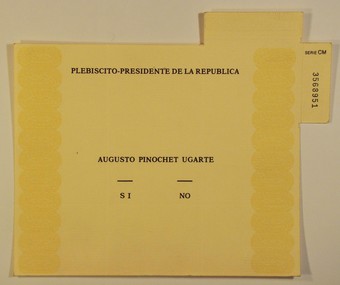
Original ballot from the 1988 plebiscite
Plebiscite of October 8, 1988
The military junta began to shift leadership tactics in the late 1970s. Due to increasing resistance and
attendant problems with General Pinochet’s rule, Air Force General Gustavo Leigh
was expelled from the junta in 1978 and replaced by General Fernando Matthei.
Throughout the 1980s, the government gradually permitted greater freedom of
assembly, speech, and association, including trade union activities. In 1985,
Cesar Mendoza, a member of the junta since 1973, was forced to resign as a
result of the Caso Degollados (“slit throats case”) in which three Communist
Party members were assassinated. The following year, Carmen Gloria Quintana, a
woman detained by an army patrol during a street demonstration against Pinochet,
was burned alive in what became known as the Caso Quemado (“burnt alive case”),
rallying those who believed the country should move towards a more democratic
form of governance. It was in this context that the 1988 Chilean national
plebiscite took place, in which voters would accept or reject a single
candidate proposed by the military junta.
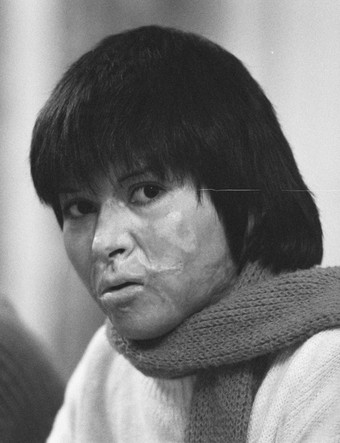
Carmen Gloria Quintana in 1987
Quintana, a Chilean woman detained during a street demonstration against Pinochet,
was burned alive in what became known as the Caso Quemado (“burnt alive case”).
The plebiscite presented two choices to voters: vote yes and extend
Pinochet’s mandate for another eight years, or vote no and Pinochet and the
junta would continue in power for only one more year. The outcome was that
Pinochet was denied a second eight-year term by 54.5% of the vote. Presidential
and parliamentary elections would take place three months before Pinochet’s
term expired, with the newly elected president and Congress taking office March
11, 1990. The fact that the dictatorship respected the results is attributed to
pressure from big business, the international community, and general popular unease
with Pinochet’s rule. Open presidential and congressional elections were held in
December 1989, and the new democratically-elected president, Patricio Aylwin of
the Christian Democratic Party, assumed power as planned in March. Due to the
transitional provisions of the constitution, Pinochet remained as
Commander-in-Chief of the Army until March 1998.
36.4: Brazil
36.4.1: The Old Republic
Governance in Brazil’s Old Republic wavered
between state autonomy and centralization.
Learning Objective
Describe the regime of the Old Republic
Key Points
- The Old Republic
covers a period of Brazilian history from 1889 to 1930, during which Brazil was a nominal constitutional democracy. - The history of
the Old Republic is dominated by a quest to find a viable form of government to
replace the preceding monarchy. This quest swung Brazil back and
forth between state autonomy and centralization. - The federal
government in Rio de Janeiro was dominated and managed by a combination of the
more powerful Brazilian states: Sao Paulo, Minas Gerais, Rio Grande do Sul, and
to a lesser extent Pernambuco and Bahia. - Brazil’s Army
developed as a national regulatory and interventionist institution within the
Old Republic. - The Constituent
Assembly that drew up the constitution of 1891 was a battleground between those
seeking to limit executive power, which was dictatorial in scope under
President Deodoro da Fonseca, and radical authoritarians who opposed the coffee
oligarchy and wanted to preserve and intensify presidential authority. - Around the start
of the 20th century, the vast majority of Brazil’s population lived in semi-feudal communities. - Brazil’s
dependence on factory-made goods and loans from technologically, economically,
and politically advanced North Atlantic countries retarded its domestic
industrial base, and its economy was not nationally integrated until pressure
was put on the government to become more interventionist during the 1920s. - With manufacturing on the rise and the coffee oligarchs imperiled by the
growth of trade associated with World War I, the old order of café com leite and coronelismo eventually gave way to the political aspirations of new
urban groups: professionals, government and white-collar workers, merchants,
bankers, and industrialists.
Key Terms
- coronelismo
-
The Brazilian political machine during the Old
Republic that was responsible for the centralization of political power in the
hands of locally dominant oligarchs, known as coronels, who would dispense
favors in return for loyalty. - latifúndios
-
An extensive parcel of privately owned land,
particularly landed estates that specialized in agriculture for export.
The First Brazilian Republic,
or Old Republic, covers a period of Brazilian history from 1889 to 1930 during
which it was governed a constitutional democracy. Democracy, however,
was nominal in the republic. In reality, elections were rigged and voters in
rural areas were pressured to vote for their bosses’ chosen candidates. If that method did not work, the election results could still be changed by one-sided decisions of Congress’ verification of powers commission (election authorities in the República Velha were not independent from the executive and the Legislature, but dominated by the ruling oligarchs). As a result, the presidency of Brazil during this period
alternated between the oligarchies of the dominant states of Sao Paulo and
Minas Gerais. The regime is often referred to as “café com leite,” or “coffee
with milk,” after the respective agricultural products of the two states.
Brazil’s Old Republic was
not an ideological offspring of the republics of the French or American
Revolutions, although the regime would attempt to associate itself
with both. The republic did not have enough popular support to risk open
elections and was born of a coup d’etat that maintained itself by
force. The republicans made Field Marshal Deodoro da Fonseca president
(1889-91) and after a financial crisis, appointed Field Marshal Floriano
Vieira Peixoto the Minister of War to ensure the allegiance of the military.
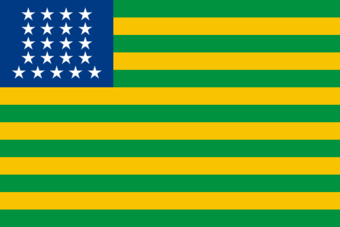
Flag of Brazil, November 15-19, 1889
The first Brazilian flag used after the monarchy’s fall.
Rule of the Landed
Oligarchies
The history of the Old
Republic is dominated by a quest to find a viable form of government to replace
the preceding monarchy. This quest swung Brazil back and forth
between state autonomy and centralization. The constitution of 1891 established
the United States of Brazil and granted extensive autonomy to the provinces,
now called states. The federal system was adopted and all powers not explicitly
granted to the federal government in the constitution were delegated to the
states. Over time, extending as far as the 1920s, the federal government in Rio
de Janeiro was dominated and managed by a combination of the more powerful
Brazilian states: Sao Paulo, Minas Gerais, Rio Grande do Sul, and to a lesser
extent Pernambuco and Bahia.
As a result, the Army
developed as a national regulatory and interventionist institution within the
republic. The sudden elimination of the monarchy left it as Brazil’s only viable, dominant
institution. Although the Roman Catholic Church
maintained a presence, it remained primarily international in its personnel,
doctrine, liturgy, and purposes. The Army even began to eclipse other military
institutions such as the Navy and the National Guard. The armed forces,
however, were divided over their status, relationship to the political regime,
and institutional goals. Therefore, the lack of military unity and disagreement
among civilian elites regarding the military’s role in society prevented the
establishment of a long-term military dictatorship within the country.
The Constituent Assembly
that drew up the constitution of 1891 was a battleground between those seeking
to limit executive power, which was dictatorial in scope under President
Deodoro da Fonseca, and the Jacobins, radical authoritarians who opposed the
coffee oligarchy and wanted to preserve and intensify presidential
authority. The constitution established a federation governed supposedly by a
president, a bicameral National Congress, and a judiciary. However, real power
rested in the hands of regional patrias and local potentates, called
“colonels”. There was a constitutional system as well as the real system of
unwritten agreements (coronelismo)
among the colonels. Under coronelism, local oligarchies chose
state governors, who selected the president.
This informal but real
distribution of power emerged as a result of armed struggles and bargaining.
The system consolidated the state oligarchies around families that were members of the old monarchical elite, and to provide a check to the Army, the
state oligarchies strengthened the navy and state police. In larger states,
state police evolved into small armies.
In the final decades of the
19th century, the United States, much of Europe, and neighboring
Argentina expanded the right to vote. Brazil, however, moved to restrict access
to the polls under the monarchy and did not correct the situation under the
republic. By 1910, only 627,000 eligible voters could be counted among a total
population of 22 million. Throughout the 1920s, only between 2.3% and 3.4% of
the total population could vote. The middle class was far from active in
political life. High illiteracy rates went hand in hand with the absence of
universal suffrage or a free press. In regions far from major urban centers,
news could take four to six weeks to arrive. In this context, a free press
created by European immigrant anarchists started to develop during the 1890s
and 1900s and spread widely, particularly in large cities.
Latifundio
Economies
Around the start of the 20th
century, the vast majority of Brazil’s population lived in semi-feudal communities. Because of the legacy of Ibero-American
slavery, abolished as late as 1888 in Brazil, there was an extreme
concentration of landownership reminiscent of feudal aristocracies: 464 great
landowners held more than 270,000 km² of land (latifúndios), while 464,000 small and medium-sized farms occupied
only 157,000 km². Large estate owners used their land to grow export products
like coffee, sugar, and cotton, and the communities who resided on his land
would participate in the production of these cash crops. For instance, most
typical estates included the owner’s chaplain and overseers, indigent peasants,
sharecroppers, and indentured servants. As a result, Brazilian producers tended
to neglect the needs of domestic consumption, and four-fifths of the country’s
grain needs were imported.
Brazil’s dependence on
factory-made goods and loans from technologically, economically, and
politically advanced North Atlantic countries retarded its domestic industrial
base. Farm equipment was primitive and largely non-mechanized. Peasants tilled
the land with hoes and cleared the soil through the inefficient slash-and-burn
method. Meanwhile, living standards were generally squalid. Malnutrition,
parasitic diseases, and lack of medical facilities limited the average life
span in 1920 to 28 years. Without an open market, Brazilian industry could not
compete against the technologically advanced Anglo-American economies. In this
context, the Encilhamento (a “boom
and bust” process that first intensified, and then crashed, in the years
between 1889 and 1891) occurred, the consequences of which were felt in all
areas of the Brazilian economy for many decades following.
During this period, Brazil
did not have a significantly integrated national economy. The absence of a big
internal market with overland transportation, except for mule trains, impeded
internal economic integration, political cohesion, and military efficiency.
Instead, Brazil had a grouping of regional economies that exported their own
specialty products to European and North American markets. The Northeast
exported its surplus cheap labor, but saw its political influence decline in
the face of competition from Caribbean sugar producers. The wild rubber boom in
Amazônia declined due to the rise of efficient Southeast Asian colonial
plantations following 1912. The national-oriented market economies of the South
were not dramatic, but their growth was steady, and by the 1920s, that growth
allowed Rio Grande do Sul to exercise considerable political leverage. Real
power resided in the coffee-growing states of the Southeast—São Paulo, Minas
Gerais, and Rio de Janeiro—that produced the most export revenue. Those three
and Rio Grande do Sul harvested 60% of Brazil’s crops, turned out 75% of its
industrial and meat products, and held 80% of its banking resources.
Struggles for Reform
Support for
industrial protectionism increased during the 1920s. Under considerable pressure
from the growing middle class, a more activist, centralized state adapted to
represent the new bourgeoisie’s interests. A policy of state intervention,
consisting of tax breaks, lowered duties, and import quotas, expanded the
domestic capital base. During this time, São Paulo was at the forefront of Brazil’s
economic, political, and cultural life. Known colloquially as a “locomotive
pulling the 20 empty boxcars” (a reference to the 20 other Brazilian states)
and Brazil’s industrial and commercial center to this day, São Paulo led the
trend toward industrialization with foreign revenues from the coffee industry.
With manufacturing on the
rise and the coffee oligarchs imperiled by the growth of trade associated with
World War I, the old order of café com
leite and coronelismo eventually
gave way to the political aspirations of the new urban groups: professionals,
government and white-collar workers, merchants, bankers, and industrialists. Prosperity
also contributed to a rapid rise in the population of working class Southern
and Eastern European immigrants—a population that contributed to the growth of
trade unionism, anarchism, and socialism. In the post-World War I period,
Brazil was hit by its first wave of general strikes and the establishment of
the Communist Party in 1922. However, the overwhelming majority of the
Brazilian population was composed of peasants with few if any ties to the
growing labor movement. As a result, social
reform movements would crop up in the 1920s, ultimately culminating in the
Revolution of 1930.
36.4.2: Years Under the Military Regime
Brazilian society experienced extreme oppression
under the military regime despite general economic growth during the Brazilian Miracle.
Learning Objective
Give examples of daily life under the military
regime in Brazil.
Key Points
- The Brazilian
military government was an authoritarian military dictatorship that ruled
Brazil from April 1, 1964 to March 15, 1985. It began with the 1964 coup d’etat
led by the armed forces against President Joao Goulart. - The military
dictatorship lasted for almost 21 years despite initial pledges to the
contrary. - On April 9,
1964, the coup leaders published the First Institutional Act, which greatly
limited the freedoms of the 1946 constitution, by granting the President authority
to remove elected officials from office, dismiss civil servants, and revoke
political rights of those found guilty of subversion or misuse of public funds
for up to 10 years. - On October 27,
1965, President Castelo Branco signed the Second Institutional Act, which set
the stage for a purge of Congress, removing objecting state governors and
expanding the President’s arbitrary powers at the expense of the legislative
and judiciary branches. - On December 13,
1968, in response to increasing resistance to the regime, Costa e Silva signed
the Fifth Institutional Act, which gave the president dictatorial powers,
dissolved Congress and the state legislatures, suspended the constitution, ended
democratic government, suspended habeas corpus, and imposed censorship. - During General Emilio Garrastazu Medici’s presidency, the greatest human
rights abuses were committed. However, Medici remained a popular president due
to the economic growth that occurred during the Brazilian Miracle.
Key Terms
- habeas corpus
-
A legal recourse whereby a person can report
unlawful detention and imprisonment before a court. - Brazilian Miracle
-
A period of exceptional economic growth in
Brazil during the rule of the Brazilian military government, which reached its
peak during the tenure of President Emilio Garrastazu Medici from 1969 to 1973.
During this time, average annual GDP growth was close to 10%.
The Brazilian military
government was an authoritarian military dictatorship that ruled Brazil from
April 1, 1964 to March 15, 1985. It began with the 1964 coup d’etat led by
armed forces against the administration of the President Joao Goulart, who had
previously served as Vice President and assumed the office of the presidency
following the resignation of democratically-elected Janio Quadros. The military
revolt was fomented by the governors of Minas Gerais, Sao Paulo, and Guanabara.
The coup was supported by the Embassy and State Department of the United
States. The fall of President Goulart worried many citizens. Many students,
Catholics, Marxists, and workers formed groups that opposed military rule. A
minority even engaged in direct armed struggle, although the vast majority of
the resistance supported political solutions to the mass suspension of human
rights. In the first few months after the coup, thousands of people were
detained, and thousands of others were removed from their civil service or
university positions.
The military dictatorship
lasted for almost 21 years despite initial pledges to the contrary. In 1967, it
enacted a new, restrictive constitution that stifled freedom of speech and
political opposition. The regime adopted as its guidelines nationalism,
economic development, and anti-communism.
Establishing the Regime
Within the Army, agreement
could not be reached as to a civilian politician who could lead the government
after the ouster of President Joao Goulart. On April 9, 1964, the coup leaders
published the First Institutional Act, which greatly limited the freedoms of
the 1946 constitution. Under the act, the President was granted authority to
remove elected officials from office, dismiss civil servants, and revoke
political rights of those found guilty of subversion or misuse of public funds
for up to 10 years. Three days after the publication of the act, Congress
elected Army Chief of Staff, Marshal Humberto de Alencar Castelo Branco to
serve as president for the remainder of Goulart’s term. Castelo Branco had
intentions of overseeing radical reforms to the political-economic system, but
refused to remain in power beyond the remainder of Goulart’s term or to
institutionalize the military as a governing body. Although he intended to
return power to elected officials at the end of Goulart’s term, competing
demands radicalized the situation.
Military hardliners wanted
to completely purge the left-wing and populist influences for the duration of
Castelo Branco’s reforms. Civilians with leftist leanings criticized Castelo
Branco for the extreme actions he took to implement reforms, whereas the military
hardliners felt Castelo Branco was acting too lenient. On October 27, 1965,
after two opposition candidates won in two provincial elections, Castelo Branco
signed the Second Institutional Act, which set the stage for a purge of
Congress, removing objecting state governors and expanding the President’s
arbitrary powers at the expense of the legislative and judiciary branches. This
not only provided Castelo Branco with the ability to repress the left, but also
provided a legal framework for the hard line authoritarian rules of Artur da
Costa e Silva (1967-69) and Emilio Garrastazu Medici (1969-74).
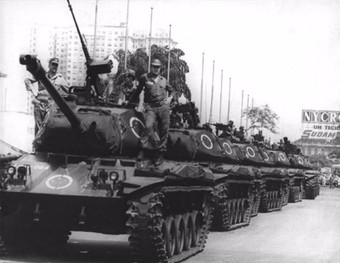
Tanks occupy President Vargas Avenue
A column of M41 Walker Bulldog tanks along the streets of Rio de Janeiro in April 1968.
These events were part of a series of building-up tensions between the people and the regime that led to further repressive polices in December 1968.
Rule of the Hardliners
Castelo Branco was succeeded
to the presidency by General Artur da Costa e Silva, a hardliner within the
regime. Experimental artists and musicians formed the Tropicalia movement
during this time, and some major popular musicians such as Gilberto Gil and
Caetano Velsos were either arrested, imprisoned, or exiled. Widespread student
protests also abounded during this period. In response, on December 13, 1968, Costa
e Silva signed the Fifth Institutional Act, which gave the president
dictatorial powers, dissolved Congress and the state legislatures, suspended
the constitution, ended democratic government, suspended habeas corpus, and
imposed censorship. The military government had already been using various
forms of torture as early as 1964 in order to gain information as well as
intimidate and silence potential opponents. This radically increased after
1968.
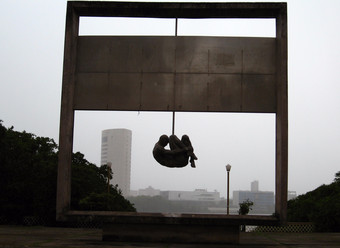
“Tortura Nunca Mais”
Monument to the victims of torture in Recife.
On August 31, 1969, Costa e Silva
suffered a stroke. Instead of his vice president assuming the office of the
presidency, all state power was assumed by the military, which then chose
General Emilio Garrastazu Medici, another hardliner, as president. During his
presidency, Medici sponsored the greatest human rights abuses of the time
period. Persecution and torture of dissidents, harassment against journalists,
and press censorship became ubiquitous. A succession of kidnappings of foreign
ambassadors in Brazil embarrassed the military government. Reactions such as
anti-government manifestations and guerrilla movements generated increasing
repressive measures in turn. By the end of 1970, the official minimum wage went
down to US $40 a month, and as a result, the more than one-third of the Brazilian
workforce that made minimum wage lost approximately half their purchasing power
in relation to 1960 levels.
Nevertheless, Medici was
popular because his term was met with the largest economic growth of any
Brazilian President, a period of time popularly known as the Brazilian Miracle.
The military entrusted economic policy to a group of technocrats led by Minister
of Finance Delfim Netto. During these years, Brazil became an urban society
with 67% of people living in cities. The government became directly involved in
the economy, investing heavily in new highways, bridges, and railroads. Steel
mills, petrochemical factories, hydroelectric power plants, and nuclear
reactors were also built by large state-owned companies like Eletrobras and
Petrobras. To reduce reliance on imported oil, the ethanol industry was heavily
promoted.
By 1980, 57% of Brazil’s exports were industrial goods compared to 20%
in 1968. Additionally, average annual GDP growth was close to 10%. Comparatively,
during President Goulart’s rule, the economy had been nearing a crisis, with
annual inflation reaching 100%. Additionally, Medici presented the First
National Development Plan in 1971, which aimed at increasing the rate of
economic growth, particularly in the Northeast and Amazonia. Brazil also won
the 1970 Football World Cup, promoting national pride and Brazil’s
international profile.
36.4.3: Brazil’s Growing Economy
Brazil’s economy is
characterized by moderately free markets and an inward-oriented approach to development.
Learning Objective
Detail some of the reasons for Brazil’s economic
growth in the latter 20th century
Key Points
- From 2000 to
2012, Brazil was one of the fastest growing major economies of the world, with
an average annual GDP growth rate of over five percent. And from roughly 1968
to 1980, Brazil’s average annual GDP growth rate was approximately ten percent
during what was dubbed the Brazilian Miracle. -
Much of Brazil’s
economic growth during the Brazilian Miracle can be attributed to a group of
technocrats led by Minister of Finance Antonio Delfim Netto, to whom the
military government entrusted economic policy. - The government
became directly involved in the economy, investing heavily in infrastructure,
building, and reducing reliance on imports. - As a result of
this industrial growth and investment in infrastructure, Brazil became an urban
society, with 67% of its population living in cities. - However, to continue fueling its economic growth, Brazil needed
more imported oil, and in the 1970s, a series of international energy crises
contributed to a deceleration in growth.
Key Terms
- recession
-
In economics, a business cycle contraction that
results in a general slowdown in economic activity. Macroeconomic indicators
such as GDP (gross domestic product), investment spending, capacity
utilization, household income, business profits, and inflation fall, while
bankruptcies and the unemployment rate rise. - hyperinflation
-
In economics, when a
country experiences very high and often accelerating rates of inflation,
rapidly eroding the real value of the local currency and causing the population
to minimize their holdings of local money, normally switching to
relatively stable foreign currencies.
From 2000 to 2012, Brazil
was one of the fastest growing major economies of the world, with an average
annual GDP growth rate of over five percent. In 2012, Brazil’s economy temporarily
became the world’s sixth largest economy, surpassing that of the United
Kingdom. However, Brazil’s economic growth decelerated in 2013 and the country
entered a recession in 2014. Similarly, Brazil’s development during the 1960s
was so impressive it was dubbed the Brazilian Miracle. During that time, Brazil
opened its markets and took an inward-looking approach to economic development.
Its economic growth was only impeded by a series of international energy crises
during the 1970s.
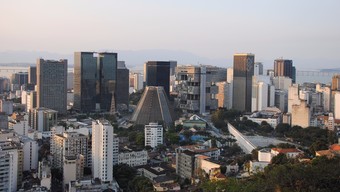
Central Rio de Janeiro
Central business district of Rio de Janeiro.
The Brazilian Miracle
The Brazilian Miracle refers
to a period between 1968 and 1980 during which Brazil experienced exceptional
economic growth during the rule of its military government. During that time,
the average annual GDP growth was close to ten percent. Economic growth was
particularly strong from 1969 to 1973 during the tenure of President Emilio
Garrastazu Medici. Perception of the so-called golden age of Brazilian
development was strengthened in 1970 when Brazil won the FIFA World Cup for the
third time and the military government adopted the official slogan, “Brasil,
ame-o ou deixe-o” (“Brazil, love it or leave it”).
Much of Brazil’s economic
growth can be attributed to a group of technocrats led by Minister of Finance,
Agriculture, and Planning Antonio Delfim Netto, to whom the military government
entrusted economic policy. The government became directly involved in the
economy, investing heavily in new highways, bridges, and railroads. Steel
mills, petrochemical factories, hydroelectric power plants, and nuclear
reactors were also built by large state-owned companies such as Eletrobras and
Petrobras. Additionally, to reduce reliance on imported oil, the ethanol
industry was heavily promoted. By 1980, 57% of Brazil’s exports were industrial
goods compared to just 20% in 1968.
Energy Crises and
Deceleration of Growth
As a result of this
industrial growth and investment in infrastructure, Brazil became an urban
society, with 67% of its population living in cities. Sao Paulo, in particular,
grew quickly due to a population influx from the poorer countryside. However,
to continue fueling its economic growth, Brazil needed more imported
oil. In the early to mid-1970s, President Ernesto Geisel removed long-time
Minister of Finance Netto and opened Brazil to oil prospecting by foreign firms
for the first time since the 1950s, fending off nationalist objections. Although
its growth and borrowing were sustainable during the early years of the
Brazilian Miracle, the 1973 global oil crisis required the military government
to borrow increasingly from international lenders to cover the rising
costs of fuel, and the resultant debt became unmanageable. By the end of the decade,
Brazil had the largest debt in the world at approximately US $92 billion.

Sao Paulo at Night
The Itaim Bibi Financial District of Sao Paulo, Brazil, shot by Rodrigo Ono.
As a result of the energy
crises of the 1970s, Brazil experienced a 14-year period of hyperinflation from
1980 until 1994. During this time, the republic cycled through several
short-lived currencies, including the cruzado, cruzado novo, cruzeiro, and
cruzeiro real. In 1994, the Brazilian real was introduced and proved stable
and enduring. Brazil also suffered drastic reductions in its terms of
trade as a result of the 1973 oil crisis. In the early 1970s, the performance
of the export sector was undermined by Brazil’s overvalued currency. With the
trade balance under pressure, the oil shock led to a sharply increased import bill,
raising import requirements and the already large
current-account deficit.
Brazil shifted its foreign policy to meet its economic needs. Due to its
reliance on foreign oil, Geisel shifted its strict alignment with the U.S. and its
allies to a more pragmatic approach, including a more neutral stance on
Middle Eastern political affairs. His government also recognized the People’s
Republic of China and the new socialist governments of Angola and Mozambique,
both former Portuguese colonies. The government moved closer to Japan and Latin
American and European countries as well.
36.5: Conflict Across Latin America
36.5.1: Cuba and the Castros
The Castros rose to power against a backdrop of
widespread dissatisfaction with Fulgencio Batista’s corrupt and repressive regime.
Learning Objective
Discuss the rise of the Castros
Key Points
- Fidel Alejandro
Castro Ruz was a Cuban revolutionary and politician who governed the Republic
of Cuba as Prime Minister from 1959 to 1976 and then as President from 1976 to
2008. Under his administration, Cuba became a one-party socialist state, industry
and business were nationalized, and state socialist reforms were implemented
throughout society. -
In the decades
following its independence from Spain in 1902, Cuba experienced a period of
significant instability, enduring a number of revolts, coups, and periods of U.S. military intervention. - Fulgencio
Batista, a former soldier who served as the elected president of Cuba from
1940 to 1944, became president for the second time in March 1952 after seizing
power in a military coup. Although Batista was supported by the Communist
Party of Cuba during his first term as President, he became strongly
anti-communist during his second term, gaining him political and military support
from the United States. - Fidel Castro
petitioned for the overthrow of Batista, whom he accused of corruption and
tyranny; however, Castro’s constitutional arguments were rejected by the Cuban
courts. After deciding that the Cuban regime could not be replaced via legal
avenues, Castro resolved to launch an armed revolution. - Castro’s Movement
attacked a number of military installations, after which he and his brother Raul
were imprisoned. Upon release, he took his Movement to Mexico to regroup. - At the end of
1956, the Movement returned to Cuba, using the Sierra Maestra mountain range as its base.
Fighting between the Movement and the Batista regime would continue off and on through
the beginning of 1959. -
The US imposed
an economic embargo on the Cuban government and recalled its ambassador during
the conflict, further weakening the Batista government’s mandate. Batista’s
support among Cubans began to fade, with former supporters either joining the
revolutionaries or distancing themselves from the regime. - On August 21,
1958, Castro’s forces began an offensive in the Oriente province, proceeding
west from the Sierra Maestra mountain range toward Santa Clara. On January 2, 1959, the
military stopped resisting their progress and Castro took the city, ending the
revolution in a victory for his Movement. - The Cuban
Revolution was a crucial turning point in U.S.-Cuban relations, with the American
establishment fearing further Communist insurgencies would spread throughout
Latin America as they had in Southeast Asia. - As the Americans took a harder line against the Cuban revolutionary
government, the Soviet Union became Cuba’s main ally and ideological influence.
Key Terms
- embargo
-
An embargo (derived from the Spanish word embargo) is the partial or complete
prohibition of commerce and trade with a particular country or group of
countries. Embargoes are considered a strong diplomatic measure to elicit
a specific result from the country on which it is imposed. Embargoes are
similar to economic sanctions and are generally considered legal barriers to
trade as opposed to blockades, which are acts of war. - escopeteros
-
Scouts and pickets from the Sierra Maestra and
other mountain ranges during the Cuban Revolution. They were responsible for
semi-continuously holding terrain against smaller sized Batista patrols, as
well as providing first alerts, communications, protected supply routes,
essential intelligence, and captured weapons to the mainline Castro forces in
the high mountains.
Fidel Alejandro Castro Ruz
was a Cuban revolutionary and politician who governed the Republic of Cuba as
Prime Minister from 1959 to 1976 and then as President from 1976 to 2008.
Politically a Marxist-Leninist and Cuban nationalist, he also served as the
First Secretary of the Communist Party of Cuba from 1961 until 2011. Under his
administration, Cuba became a one-party socialist state, industry and business
were nationalized, and state socialist reforms were implemented throughout
society.
Background and Causes of the
Cuban Revolution
In the decades following its
independence from Spain in 1902, Cuba experienced a period of significant instability,
enduring a number of revolts, coups, and periods of U.S. military intervention.
Fulgencio Batista, a former soldier who served as the elected president of
Cuba from 1940 to 1944, became president for the second time in March 1952 after
seizing power in a military coup and canceling the planned 1952 elections.
Although Batista was relatively progressive during his first term, he
proved far more dictatorial and indifferent to popular concerns in the 1950s.
While Cuba remained plagued by high unemployment and limited water
infrastructure, Batista antagonized the population by forming lucrative links to
organized crime and allowing American companies to dominate the Cuban economy. Throughout
the 1950s, Havana became the setting for the American mafia, corrupt law
enforcement officials, and their political elected cronies to profit off
gambling, prostitution, and the drug trade. By the
end of the 1950s, Havana had about 270 brothels. Additionally, marijuana and cocaine
were as plentiful as and sometimes similarly priced to alcohol.
Although Batista was supported by the Communist Party of Cuba during his first term as President, he
became strongly anti-communist during his second term, gaining him political
and military support from the United States. Batista also developed a powerful
security infrastructure to silence political opponents during his second
term. In the months following the March 1952 coup, Fidel Castro, then a young
lawyer and activist, petitioned for the overthrow of Batista, whom he accused
of corruption and tyranny; however, Castro’s constitutional arguments were
rejected by the Cuban courts. After deciding that the Cuban regime could not be
replaced via legal avenues, Castro resolved to launch an armed revolution. To
this end, he and his brother Raul founded a paramilitary organization known as
“The Movement,” stockpiling weapons and recruiting around 1,200 followers from
Havana’s disgruntled working class by the end of 1952.
The Revolution
Fidel and Raul gathered
Movement fighters and attacked a number of military installations, including
the Moncada Barracks in Santiago. Many rebels were captured and executed by the
military, and Fidel and Raul were imprisoned following a highly political trial
in which Fidel defended himself for nearly four hours, ending with the infamous
words, “Condemn me, it does not matter. History will absolve me.” The brothers
were sentenced to more than 10 years each, but released in 1955 as a result of broad
political pressure placed upon the Batista government. Soon after
their release, the brothers traveled to Mexico with a group of exiles to
prepare for Batista’s overthrow. In June 1955, Fidel met with the Argentine
revolutionary Ernesto “Che” Guevara, who joined his cause. The revolutionaries
named themselves the 26th of July Movement in reference to the
attack on the Moncada Barracks that took place on that date in 1953.
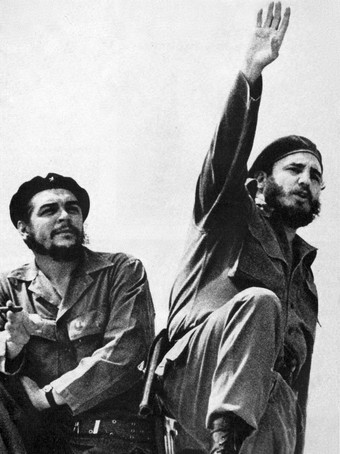
Che and Fidel
Revolutionary leaders Che Guevara (left) and Fidel Castro (right) in 1961.
On November 25, 1956, the 26th
of July Movement departed Veracruz, Mexico for Cuba, arriving a week later.
They took to the Sierra Maestra mountains, a range in southeastern Cuba, and
were attacked three days after beginning their trek by Batista’s army. No more
than 20 of the original 82 participants survived. On March 13, 1957, a separate
group of revolutionaries, the anticommunist Student Revolutionary Directorate
(RD), stormed the Presidential Palace in Havana, attempting to assassinate
Batista and decapitate the government. The attack failed and the RD’s leader
was killed during a shootout.
After this, the United States imposed an economic embargo on the Cuban government and recalled its
ambassador, further weakening the Batista government’s mandate. As a result,
Batista’s support among Cubans began to fade, with former supporters either
joining the revolutionaries or distancing themselves from the regime.
Nonetheless, the mafia and U.S. businessmen maintained their support for the
regime. Batista’s government resorted to brutal methods to keep Cuba’s cities
under control.
Meanwhile, Castro’s forces
in the Sierra Maestra mountains staged successful attacks on small garrisons of
Batista’s troops. Additionally, poorly armed irregular forces not associated
with Castro known as escopeteros
harassed Batista’s forces in the foothills and plains of Oriente Province.
Eventually the escopeteros provided
direct military support to Castro’s main forces by protecting supply lines and
sharing intelligence. Over time, the Sierra Maestra mountains came under
Castro’s complete control. In addition to armed resistance, the rebels used
propaganda to their advantage. A pirate radio station called Radio Rebelde
(“Rebel Radio”) was set up in February 1958, allowing Castro and his forces to
broadcast their message nationwide within enemy territory.
Although Castro’s forces
remained fairly small, they were continuously successful in forcing
Batista’s army to retreat whenever the two forces met. Finally, Batista
responded to Castro’s successes with an attack on the mountains called
Operation Verano, or to the rebels, la Ofensiva. The operation was close for
some time, but the tide turned in Batista’s favor on July 29, 1958, when his
troops almost completely destroyed Castro’s 300-man army at the Battle of Las
Mercedes. Castro asked for and was granted a cease-fire on August 1. Within a
week, Castro’s forces escaped back into the mountains.
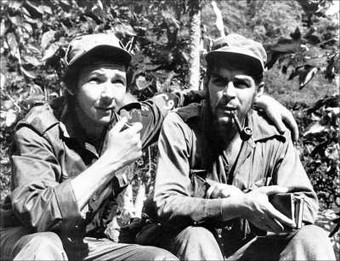
Raúl Castro and Che Guevara
Raúl Castro (left) with his arm around his second-in-command, Ernesto “Che” Guevara, in their Sierra de Cristal mountain stronghold in Oriente Province, Cuba, in 1958.
On August 21, 1958, Castro’s
forces began their own offensive in the Oriente province, proceeding west
toward Santa Clara. As a column of rebels led by Guevara entered territory where the
RD had been fighting Batista’s forces, the two groups, seeing past initial
friction, joined together to rout the army. By December 31, 1958, both groups
of rebels met with the 26th of July Movement troops headed by Camilo
Cienfuegos in Santa Clara, and the city fell to their combined forces. News of
his defeat in Santa Clara caused Batista to panic, and he fled to the Dominican
Republic hours later. When Castro learned of Batista’s flight from Cuba, he
began negotiations to take over Santiago de Cuba. On January 2, 1959, the
military commander in the city ordered troops not to fight, and Castro’s forces
took the city. Castro then arrived in Havana on January 8 after a long victory
march.
International Reactions and
Foreign Policy
The Cuban Revolution was a
crucial turning point in U.S.-Cuban relations. Although John F. Kennedy expressed
sympathy for the initial goals of Castro’s rebel movement and the U.S. government initially intended to recognize the new regime, the fear that
further Communist insurgencies would spread throughout Latin America as they
had in Southeast Asia caused a reverse in tactics. After the revolutionary
government nationalized all U.S. property in Cuba in August 1960, the Eisenhower
administration froze all Cuban assets on American soil, severed diplomatic
ties, and tightened its embargo of Cuba. In 1961, the U.S. government backed an
armed counter-revolutionary assault on the Bay of Pigs with the aim of ousting
Castro, but the counter-revolutionaries were swiftly defeated by the Cuban
military. Castro, meanwhile, resented the Americans for providing aid to
the Batista government during the revolution and attempting to subvert
the Cuban revolutionary government militarily and economically in subsequent
years.
Following the American embargo, the Soviet Union became Cuba’s main ally
and ideological influence. The two Communist countries quickly developed close
military and intelligence ties, culminating in the stationing of Soviet nuclear
weapons in Cuba in 1962, an act that triggered the Cuban Missile Crisis. Influenced
by the expansion of the Soviet Union into Europe after the 1917 Russian
Revolution, Castro sought to export his revolution to other countries in the Caribbean
and beyond, sending weapons to Algerian rebels as early as 1960. In the
following decades, Cuba became heavily involved in supporting Communist
insurgencies and independence movements in many developing countries, sending
military aid to insurgents in Ghana, Nicaragua, and Yemen, among others. Cuba continued
to maintain close links to the Soviets until the Soviet Union’s collapse in
1991. The end of Soviet economic aid led to an economic crisis and famine
throughout Cuba known as the Special Period.
36.5.2: The Guatemalan Civil War
The Guatemalan Civil War spanned nearly four
decades, stemmed from a number of institutionalized grievances among different
social classes, and included a large-scale, one-sided campaign of violence
against the civilian population by the state.
Learning Objective
Explain the controversy surrounding the
Guatemalan Civil War
Key Points
- The Guatemalan
Civil War took place from 1960 to 1996 between the government of
Guatemala and various leftist rebel groups supported chiefly by ethnic Maya
indigenous people and Ladino peasants, who together made up the rural poor. - Guatemalan
society was composed of three sharply defined classes throughout this period:
Criollos, Ladinos, and indigenous peoples. - Democratic
elections during the Guatemalan Revolution in 1944 and 1951 brought popular
leftist governments to power, but a U.S.-backed coup in 1954 installed the
military regime of Carlos Castillo Armas, who was followed by a series of
conservative military dictators. - On November 13,
1960, a group of left-wing officers from the national military academy led a
failed revolt against the autocratic government of General Ydigoras Fuentes. The
surviving officers fled into the hills of eastern Guatemala and established an
insurgent movement known as the MR-13 (Movimiento Revolucionario 13 Noviembre). - As well as
fighting between government forces and rebel groups, the conflict included a
large -scale, coordinated campaign of one-sided violence by the Guatemalan state
against the civilian population. - In 1970, Colonel
Carlos Manuel Arana Osorio became the first of a series of military dictators
representing the Institutional Democratic Party or PID that would rule the
country for the next 12 years. - Starting in
1983, de facto president Mejía Victores allowed a gradual return to democracy
in Guatemala. - Under de Leon,
the peace process, now brokered by the United Nations, took on new life. The
government and the URNG signed agreements on human rights (March 1994),
resettlement of displaced persons (June 1994), historical clarification (June
1994), and indigenous rights (March 1995). - Under the Arzú administration, peace negotiations were concluded, and
the government and URNG, which became a legal party, signed peace accords
ending the 36-year internal conflict in December 1996.
Key Terms
- disappeared
-
A person who is secretly abducted or imprisoned
by a state or political organization, or by a third party with the
authorization, support, or acquiescence of a state or political organization.
Following abduction, there is a refusal to acknowledge the person’s fate or
whereabouts, essentially placing the victim outside the protection of the law. - genocide
-
The intentional act to destroy a people (usually
defined as an ethnic, national, racial, or religious group) in whole or in
part.
The Guatemalan Civil War took
place from 1960 to 1996. It was fought between the government of Guatemala and
various leftist rebel groups supported chiefly by ethnic Maya indigenous people
and Ladino peasants, who together make up the rural poor. The government forces
of Guatemala have been condemned for committing genocide against the Maya
population of Guatemala during the civil war and for widespread human rights
violations against civilians.
Background
After the 1871 revolution,
the Liberal government of Justo Rufino Barrios escalated coffee production in
Guatemala, which required much land and many workers. To support these needs, Barrios established the Settler Rule Book, which forced the
native population work for low wages for Criollo and German settler
landowners. Barrios also confiscated the native population’s land, which had
been protected during Spanish rule and the Conservative government of Rafael
Carrera. Barrios redistributed the confiscated land to his Liberal friends, who
in turn became important landowners.
Societal Structure
Guatemalan society was
composed of three sharply defined classes throughout this period. Criollos were
a minority group who descended from both the ancient families of the Spaniards
that conquered Central America and the Indians who had been conquered by
the Spaniards. As of the 1920s, the Criollos led the country both politically
and intellectually by virtue of their education, which, although poor by
European standards of the time, remained superior to that of the
rest of the people in the country. That was partially because Criollo families controlled
or owned most of the cultivated areas of Guatemala and were the only group
allowed in either of the main political parties. The Guatemalan middle class,
Ladinos, was composed of people with heritage from the native and black populations
as well as Criollos. Ladinos held almost no political power in the 1920s and
made up the bulk of artisans, storekeepers, tradesmen, and minor officials. In
the eastern part of the country, many Ladinos were agricultural laborers.
The majority of the
Guatemalan population was composed of indigenous peoples referred to as
Indians. Many had no formal education and served as
soldiers or agricultural workers. Within the indigenous population were further
categories: “Mozos colonos” settled on plantations and were given a
small piece of land to cultivate on their own in return for their work on the
plantation itself, while “mozos jornaleros” were day-laborers who were contracted to
work for certain periods of time and paid a daily wage in return.
Both of these categories typically worked to pay off debts to higher
class individuals, who in turn encouraged the assumption of further debt on the
part of the indigenous person. Often, due to the large amount of debt and small
amount of pay, a mozo essentially became an indentured servant to the owner of
their debt. If a mozo refused to work or attempted to run away, the owner of
their debt could have them pursued and even imprisoned. Nonetheless, some
indigenous people remained independent tillers, who lived
in remote provinces and survived by growing a subsistence crop of maize, beans,
or wheat. Occasionally a small margin of their crop would be available for sale
in town markets, but the travel to get to these markets could be arduous.
Initial Phases of the Civil
War
Democratic elections during
the Guatemalan Revolution in 1944 and 1951 brought popular leftist
governments to power, but a United States backed coup d’état in 1954 installed
the military regime of Carlos Castillo Armas, followed by a series of
conservative military dictators. On November 13, 1960, a group of left-wing
junior military officers from the national military academy led a failed revolt
against the autocratic government of General Ydigoras Fuentes, who usurped
power in 1958 following the assassination of incumbent Armas. The surviving
officers fled into the hills of eastern Guatemala and later established
communication with the Cuban government of Fidel Castro. By 1962, those
surviving officers had established an insurgent movement known as the MR-13
(Movimiento Revolucionario 13 Noviembre), named after the date of the initial officers’
revolt. Through the early phase of the conflict, the MR-13 was a principal
component of the insurgent movement in Guatemala.
The MR-13 later initiated
contact with the outlawed PGT (Guatemalan Labour Party), composed and led by
middle-class intellectuals and students, and a student organization called the
Movimiento 12 de Abril (April 12 Movement). These groups merged into an
coalition guerrilla organization called the Rebel Armed Forces (FAR) in December
1962. Also affiliated with the FAR was the FGEI (Edgar Ibarra Guerrilla Front).
The MR-13, PGT, and FGEI each operated in different parts of the country as
three separate “frentes” (fronts). The MR-13 established itself in
the mostly Ladino departments of Izabal and Zacapa. The FGEI established itself
in Sierra de las Minas, and the PGT operated as an urban guerrilla front. Each
of these three “frentes” (comprising no more than 500 combatants)
was led by former members of the 1960 army revolt who has been
trained in counterinsurgency warfare by the United States.
As well as fighting between
government forces and rebel groups, the conflict included a large-scale,
coordinated campaign of one-sided violence by the Guatemalan state against the
civilian population from the mid-1960s onward. The military intelligence
services (G2 or S2) and an affiliated intelligence organization known as La
Regional or Archivo, headquartered in an annex of the presidential palace, were
responsible for coordinating killings and “disappearances” of
opponents of the state, suspected insurgents, and those deemed by the
intelligence services to be collaborators. The Guatemalan state was the first
in Latin America to engage in widespread use of forced disappearances against
its opposition, with the number of disappeared estimated at between 40,000 and
50,000 from 1966 until the end of the war. In rural areas where the insurgency
maintained its strongholds, the repression amounted to wholesale slaughter of
the peasantry and massacres of entire villages, starting in Izabal and Zacapa (1966–68)
and later in the predominantly Mayan western highlands. In the
early 1980s, the killings reached the scale of
genocide.
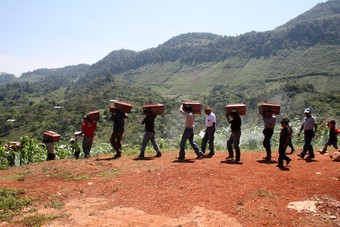
Exhumation in the Ixil triangle in Guatemala
Queqchí people carrying their loved one’s remains after an exhumation in Cambayal in Alta Verapaz department, Guatemala in February 2012. Since 1997, the Centre of Forensic Anthropology and Applied Sciences (CAFCA) has been helping to heal the deep wounds caused by Guatemala’s internal conflict.
Domination by Military
Rulers
In 1970, Colonel Carlos
Manuel Arana Osorio became the first of a series of military dictators
representing the Institutional Democratic Party, or PID. The PID dominated
Guatemalan politics for 12 years via electoral fraud favoring two of Arana’s
proteges: General Kjell Eugenio Laugerud Garcia in 1974 and General Romeo Lucas
Garcia in 1978. Also during the 1970s, continuing social discontent gave rise
to an insurgency among large populations of indigenous people and peasants, who
traditionally bore the brunt of unequal land tenure.The PID lost its grip on Guatemalan
politics when General Efraín Ríos Montt, together with a group of junior army
officers, seized power in a military coup on March 23, 1982. During the 1980s,
the Guatemalan military assumed almost absolute government power for five
years. It successfully infiltrated and eliminated enemies in every
socio-political institution of the nation, including the political, social, and
intellectual classes. In the final stage of the civil war, the military
developed a parallel, semi-visible, low profile, but high-effect, control of
Guatemala’s national life.
Mejia Victores Regime and
Democratic Transition
Ríos Montt was deposed on
August 8, 1983, by his own Minister of Defense, General Óscar Humberto Mejía
Victores. Mejía Victores became de facto president and justified the coup by characterizing
Montt’s regime as corrupt and its officials as abusing their positions of power
within the government. Montt remained in politics, founding the Guatemalan
Republican Front party in 1989. He was elected President of Congress in 1995
and 2000. By the time Mejia Victores assumed power, the counterinsurgency under
Lucas Garcia and Montt had largely succeeded in its objective of detaching the
insurgency from its civilian support base. Additionally, G2 had infiltrated most political institutions, eradicating opponents in the
government through terror and selective assassinations. The counterinsurgency
program had militarized Guatemalan society, creating a fearful atmosphere that suppressed most public agitation and insurgency. The military had
consolidated its power in virtually all sectors of society.
Due to international
pressure as well as pressure from other Latin American nations, Mejía Victores
allowed a gradual return to democracy in Guatemala. On July 1, 1984, an election
was held for representatives to a Constituent Assembly to draft a democratic
constitution. On May 30, 1985, the Constituent Assembly finished drafting a new
constitution, which took effect immediately. General elections were scheduled
and civilian candidate Vinicio Cerezo was elected as president. The gradual
revival of democracy did not end the disappearances and death squad killings,
however, as extrajudicial state violence had become an integral part of the
political culture.
The Democratic Era
Cerezo Administration
Vinicio Cerezo, a civilian
politician and the presidential candidate of the Guatemalan Christian
Democracy, won the first election held under the new constitution with almost
70% of the vote. Upon its inauguration in January 1986, President Cerezo’s
civilian government announced that its top priorities would be to end the
political violence and establish rule of law. Reforms included new laws of
habeas corpus and amparo
(court-ordered protection), the creation of a legislative human rights
committee, and the establishment in 1987 of the Office of Human Rights
Ombudsman. The Supreme Court also embarked on a series of reforms to fight
corruption and improve legal system efficiency.
With Cerezo’s election, the
military moved away from governing and returned to the more traditional role of
providing internal security, specifically by fighting armed insurgents. The
first two years of Cerezo’s administration were characterized by a stable
economy and a marked decrease in political violence. Dissatisfied military
personnel made coup attempts in May 1988 and May 1989, but military
leadership supported the constitutional order. The government was heavily
criticized for its unwillingness to investigate or prosecute cases of human
rights violations, however.
Presidential and
congressional elections were held on November 11, 1990. After the second-round
ballot, Jorge Antonio Serrano Elías was inaugurated on January 14, 1991, completing the first transition from one democratically elected civilian
government to another. Because his Movement of Solidarity Action (MAS) Party
gained only 18 of 116 seats in Congress, Serrano entered into a tenuous
alliance with the Christian Democrats and the National Union of the Center
(UCN).
Serrano Administration
The Serrano administration’s
record was mixed. It had some success in consolidating civilian control over
the army, replacing a number of senior officers and persuading the military to
participate in peace talks with the Guatemalan National Revolutionary Unity, or
URNG, an umbrella organization representing leftist beliefs among the
Guatemalan people, particularly the poor. He took the politically unpopular
step of recognizing the sovereignty of Belize, which until then was officially though fruitlessly claimed by Guatemala. The Serrano government
reversed the economic slump it inherited, reducing inflation and creating real growth. Then on May 25, 1993, Serrano illegally dissolved Congress and
the Supreme Court and attempted to restrict civil freedoms, allegedly in
order to fight corruption. The auto-coup failed due to the unified efforts of
most elements of Guatemalan society to protest Serrano’s actions, international
pressure, and the army’s enforcement of the decisions of the Court of
Constitutionality, which ruled against the attempted takeover.
Subsequently, Serrano fled
the country and pursuant to the provisions of the 1985 constitution, the
Guatemalan Congress elected the Human Rights Ombudsman, Alfonso Guillermo de
León Marroquín, to complete Serrano’s presidential term as of June 5, 1993. De
Leon was not a member of any political party and lacked a political base. Nonetheless,
he enjoyed strong popular support. During his time in office, he launched an
ambitious anti-corruption campaign within Congress and the Supreme Court,
demanding the resignations of all members of the two bodies.
Renewed Peace Process (1994
to 1996)
Under de Leon, the peace
process, now brokered by the United Nations, took on new life. The government
and the URNG signed agreements on human rights (March 1994), resettlement of
displaced persons (June 1994), historical clarification (June 1994), and
indigenous rights (March 1995). They also made significant progress on a socioeconomic
and agrarian agreement.
National elections for
president, Congress, and municipal offices were held in November 1995. With
almost 20 parties competing in the first round, the presidential election came
down to a January 7, 1996, run-off in which National Advancement Party (PAN)
candidate Álvaro Arzú Irigoyen defeated Alfonso Portillo Cabrera of the Guatemalan
Republican Front (FRG) by just over two percent of the vote. Arzú won because
of his strength in Guatemala City, where he previously served as mayor, and
in the surrounding urban area. Portillo won all of the rural departments except
Petén. Under the Arzú administration, peace negotiations were concluded, and
the government and URNG, which became a legal party, signed peace accords
ending the 36-year internal conflict in December 1996. The General Secretary of
the URNG, Comandante Rolando Morán, and President Álvaro Arzú jointly received
the UNESCO Peace Prize for their efforts to end the civil war and attain the
peace agreement. The United Nations Security Council adopted Resolution 1094 on
January 20, 1997, deploying military observers to Guatemala to monitor the
implementation of the peace agreements.
Legal Charges of Crimes
Against Humanity
In total, an estimated
200,000 civilians were killed or “disappeared” during the
conflict, most at the hands of the military, police, and intelligence services.
Victims of the repression included indigenous activists, suspected government
opponents, returning refugees, critical academics, students, left-leaning
politicians, trade unionists, religious workers, journalists, and street
children. The “Comisión para el Esclarecimiento Histórico” has
estimated that 93% of the violence committed during the conflict was carried
out by government forces and 3% by guerrillas. In 2009, Guatemalan courts
sentenced the first person to be convicted of the crime of ordering forced
disappearances, Felipe Cusanero. This was followed by the 2013 trial of former
president Montt for the killing and disappearances of more than 1,700 indigenous
Ixil Maya during his 1982-83 rule. The accusations of genocide derived from the
“Memoria del Silencio” report written by the UN-appointed Commission
for Historical Clarification, which held that genocide could have occurred in
Quiché between 1981 and 1983.
The first former head of state to be tried for genocide by his own
country’s judicial system, Montt was found guilty the day following the
conclusion of his trial and sentenced to 80 years in prison. A few days
later, however, the sentence was reversed and the trial was rescheduled due to alleged judicial anomalies. The trial began again in 2015. The
court decided, due to his alleged senility, that a closed door trial would resume
in January 2016, and that if Montt were found guilty, a jail sentence
would be precluded given his health condition.
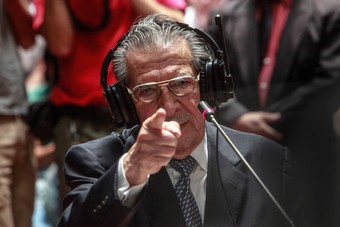
Ex-General Efrain Rios Montt testifying during his trial on March 19, 2013
Montt
declared himself innocent: “I am innocent. I never had the intention of destroying any national ethnic group. My role as head of State was specifically to bring the nation back on track, after it had gone astray.”
36.5.3: From the Somozas to the Sandinistas in Nicaragua
In the 20th century, Nicaragua
transitioned from an oligarchic dictatorship to the revolutionary government of
a democratic socialist political party.
Learning Objective
Outline events in Nicaragua moving from the
Somozas to the Sandinistas
Key Points
- The longest dictatorship
in Nicaragua’s history was the hereditary dictatorship of the Somoza family,
who ruled for 43 years during the 20th century. - The Somoza
family was among a few families or groups of influential firms that reaped most
of the benefits of the country’s growth from the 1950s to the 1970s. -
In 1961, Carlos
Fonseca and two others founded the Sandinista National Liberation
Front (FSLN). - On December 27,
1974, a group of nine FSLN guerrillas invaded a party at the home of a former
Minister of Agriculture, killing him and three guards and taking
several leading government officials and prominent businessmen hostage. Anastasio
Somoza Debayle, in his memoirs, refers to this action as the beginning of a
sharp escalation of Sandinista attacks and government reprisals. - The country
tipped into full-scale civil war with the 1978 murder of Pedro Chamorro, a
Nicaraguan journalist and publisher who opposed violence against the
regime. -
In May 1979,
another general strike was called and the FSLN launched a major push to take
control of the country. As Nicaragua’s government collapsed and the National
Guard commanders escaped with Somoza, the rebels advanced on the capital
victoriously. - On July 19,
1979, a new government was proclaimed under a provisional junta headed by
33-year-old Daniel Ortega. Then, the Sandinistas were victorious in the
national election of November 4, 1984, gathering 67% of the vote. - American support
for the Somoza family soured diplomatic relations with Nicaragua, and the FSLN
government was committed to a Marxist ideology, with many leading Sandinista individuals
continuing long-standing relationships with the Soviet Union and Cuba. With the
election of Ronald Reagan in 1980, relations between the US and the Sandinista
regime became an active front in the Cold War. - The first
challenge to the Sandanistas’ powerful new army came from the Contras, groups
of Somoza’s National Guard that had fled to Honduras and were organized,
trained, and funded by CIA elements. - Mutual exhaustion, Sandinista fears of Contra unity and military
success, and mediation by other regional governments led to a ceasefire between
the Sandinistas and the Contras on March 23, 1988. Subsequent agreements were
designed to reintegrate the Contras and their supporters into Nicaraguan
society.
Key Terms
- embargo
-
An embargo (derived from the Spanish word embargo) is the partial or complete
prohibition of commerce and trade with a particular country or group of
countries. Embargoes are considered a strong diplomatic measure to elicit
a specific result from the country on which it is imposed. Embargoes are
similar to economic sanctions and are generally considered legal barriers to trade
as opposed to blockades, which are acts of war. - Sandinista National Liberation
Front (FSLN) -
Now a democratic socialist political party, but
previously a Nicaraguan resistance organization opposed to the hereditary Somoza
dictatorship.
Somoza Dynasty (1927-1979)
Over the course of its
history, Nicaragua has experienced several military dictatorships; the longest
was the hereditary dictatorship of the Somoza family, who ruled for 43 years
during the 20th century. The Somoza family came to power as part of
a U.S.-engineered pact in 1927 that stipulated the formation of the Guardia
Nacional (National Guard) to replace the marines who had long reigned in
Nicaragua. Anastasio Somoza slowly eliminated officers in the National Guard
who might have stood in his way, then deposed President Juan Bautista Sacasa to
become Nicaragua’s new president on January 1, 1937, in a rigged election. When
Anastasio was shot and mortally wounded by Liberal Nicaraguan poet Rigoberto
Lopez Perez on September 21, 1956, his eldest son, Luis Somoza Debayle, was
appointed president by Congress and officially took charge of the country. He
is remembered as moderate, but was only in power for a few years
before dying of a heart attack. His successor as president was Rene Schick
Gutierrez, widely considered a puppet of the Somoza family.
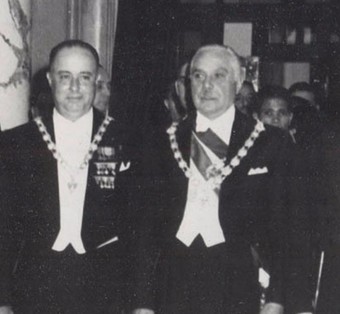
Somoza and Trujillo (1952)
Dictator-General Anastasio Somoza (left) with Dominican President Rafael Trujillo in 1952.
The Somoza family was among
a few families or groups of influential firms that reaped most of the benefits
of the country’s growth from the 1950s to the 1970s. When Anastasio Somoza
Debayle was deposed by the Sandinistas in 1979, the family’s worth was
estimated between U.S. $500 million and $1.5 billion. In 1972 when an
earthquake destroyed nearly 90% of Managua, Anastasio Somoza Debayle siphoned
off relief money instead of helping to rebuild the city. Even the economic
elite were reluctant to support Somoza following his actions as he had acquired
monopolies in industries that were key to rebuilding the nation.
Nicaraguan Revolution
(1960s-1990)
In 1961, Carlos Fonseca
turned back to the historical figure of Augusto Cesar Sandino, the charismatic
leader of Nicaragua’s nationalist rebellion against the U.S. occupation of the
country, and along with two others, founded the Sandinista National Liberation
Front (FSLN). The December 1972 Managua earthquake was a major turning point in
the revival of the Sandinistas, stoking violent opposition to the government
during a time of heightened international attention. The Sandinistas even
received some support from Cuba and the Soviet Union during this period.
On December 27, 1974, a
group of nine FSLN guerrillas invaded a party at the home of a former Minister
of Agriculture, killing him and three guards in the process of taking several
leading government officials and prominent businessmen hostage. In return for
the hostages, they succeeded in getting the government to pay U.S. $2 million
ransom, the broadcast of an FSLN declaration on the radio and in the opposition
newspaper La Prensa, the release of
14 FSLN members from jail, and flights for the raiders and the released FSLN
members to Cuba. The incident humiliated the government and greatly enhanced
the prestige of the FSLN. Anastasio Somoza Debayle, in his memoirs, refers to
this action as the beginning of a sharp escalation in terms of Sandinista
attacks and government reprisals. Martial law was declared in 1975, and the
National Guard began to raze villages in the jungle suspected of supporting the
rebels. Human rights groups condemned the actions, but U.S. President Gerald Ford
refused to break the alliance with Somoza.
The country tipped into
full-scale civil war with the 1978 murder of Pedro Chamorro, a Nicaraguan
journalist and publisher who opposed violence against the regime. Fifty
thousand people turned out for his funeral. Many assumed that Somoza
ordered his assassination because there was evidence implicating Somoza’s
son and other members of the National Guard. A nationwide strike commenced in
protest, demanding an end to the dictatorship. At the same time, the
Sandinistas stepped up their rate of guerrilla activity. Several towns,
assisted by Sandinista guerrillas, expelled their National Guard units. Somoza
responded with increasing violence and repression. When León became the first
city in Nicaragua to fall to the Sandinistas, he responded with aerial
bombardment.
The U.S. media grew
increasingly unfavorable in its reporting on the situation in Nicaragua.
Realizing that the Somoza dictatorship was unsustainable, the Carter
administration attempted to force him to leave Nicaragua. Somoza refused and
sought to maintain his power through the National Guard. At that point, the U.S. ambassador sent a cable to the White House saying it would be
“ill-advised” to call off the bombing, because such an action would
help the Sandinistas gain power. When ABC reporter Bill Stewart was executed by
the National Guard and graphic film of the killing was broadcast on TV, the
American public became more hostile to Somoza. In the end, President Carter
refused Somoza further military aid, believing that the repressive nature of
the government led to popular support for the Sandinista uprising.
Beginning of the Sandinista
Period
In May 1979, another general
strike was called, and the FSLN launched a major push to take control of the
country. By mid-July, they had Somoza and the National Guard isolated in
Managua. As Nicaragua’s government collapsed and the National Guard commanders
escaped with Somoza, the rebels advanced on the capital victoriously. On July
19, 1979, a new government was proclaimed under a provisional junta headed by
33-year-old Daniel Ortega. The FSLN took over a nation plagued by malnutrition,
disease, and pesticide contamination. Lake Managua was considered dead because
of decades of pesticide runoff, toxic chemical pollution from lakeside
factories, and untreated sewage. Soil erosion and dust storms were also a
problem in Nicaragua due to deforestation. To tackle these crises,
the FSLN created the Nicaraguan Institute of Natural Resources and the
Environment.
The Sandinistas were
victorious in the national election of November 4, 1984, gathering 67% of the
vote. The election was certified “free and fair” by the majority of
international observers, although the Nicaraguan political opposition and the
Reagan administration claimed political restrictions were placed on the
opposition by the government. The primary opposition candidate was the U.S.-backed
Arturo Cruz, who succumbed to pressure from the United States government not to
take part in the 1984 elections. Other opposition parties such as the Conservative
Democratic Party and the Independent Liberal Party were free to denounce
the Sandinista government and participate in the elections. Later, historians
such as Christopher Andrews did find evidence that the FSLN was actively
suppressing right-wing opposition parties while leaving moderate parties alone.
Communist Leanings and U.S. Contras
American support for the Somoza
family soured diplomatic relations with Nicaragua. The FSLN government
was committed to a Marxist ideology, with many leading Sandinista individuals continuing
long-standing relationships with the Soviet Union and Cuba. U.S. President Carter
initially hoped that continued American aid to the new government would keep
the Sandinistas from forming a Marxist-Leninist government aligned with the
Soviet bloc, but the Carter administration allotted the Sandinistas minimal
funding, and the Sandinistas resolutely turned away from the United States, investing
Cuban and East European assistance into a new army of 75,000. The buildup
included T-55 heavy tanks, heavy artillery, and HIND attack helicopters, an
unprecedented military buildup that made the Sandinista Army more powerful than
all of its neighbors combined.
The first challenge to the
powerful new army came from the Contras, groups of Somoza’s National Guard that
had fled to Honduras and were organized, trained, and funded by CIA elements
involved in cocaine trafficking in Central America. The Contra chain of command
included some ex-National Guardsmen, including Contra founder and commander
Enrique Bermúdez. One prominent Contra commander, however, was ex-Sandinista
hero Edén Pastora, aka “Commadante Zero”, who rejected the Leninist orientation
of his fellow commandantes. The Contras operated out of camps in neighboring Honduras
to the north and Costa Rica to the south. They engaged in a systematic campaign
of terror among the rural Nicaraguan population er to disrupt the
social reform projects of the Sandinistas. The Contra campaign and supporting Reagan administration came under criticism for the brutality and
numerous human rights violations related to these operations, including the
destruction of health centers, schools, and cooperatives at the hands of the
rebels.
With the election of Ronald
Reagan in 1980, relations between the United States and the Sandinista regime became an
active front in the Cold War. The Reagan administration insisted that the
Sandinistas posed a Communist threat, reacting particularly to the support
provided to them by Cuban president Fidel Castro and the Sandinistas’ close
military relations with the Soviets and Cubans. Opposition to the Sandanistas also
furthered the Reagan administration’s desire to protect U.S. interests in the
region, which were threatened by the policies of the Sandinista government. The
U.S. quickly suspended aid to Nicaragua and expanded the supply of arms and
training to the Contra rebels in neighboring Honduras, as well as allied groups
based in Costa Rica. American pressure against the government escalated
throughout 1983 and 1984. The Contras began a campaign of economic sabotage and
disrupted shipping by planting underwater mines in Nicaragua’s Port of Corinto,
an action condemned by the International Court of Justice as illegal. The U.S. refused to pay restitution and claimed that the ICJ was not competent to judge
the case. The UN General Assembly also passed a resolution in order to pressure
the U.S. to pay the fine.
On May 1, 1985, Reagan issued an executive order that imposed a full
economic embargo on Nicaragua, which remained in force until March 1990.
However, in 1982, legislation was enacted by the U.S. Congress to prohibit
further direct aid to the Contras. Reagan’s officials attempted to illegally
supply them out of the proceeds of arms sales to Iran and third-party
donations, triggering the Iran-Contra Affair of 1986–87. Mutual exhaustion,
Sandinista fears of Contra unity and military success, and mediation by other
regional governments led to the Sapoa ceasefire between the Sandinistas and the
Contras on March 23, 1988. Subsequent agreements were designed to reintegrate
the Contras and their supporters into Nicaraguan society in preparation for
general elections.
36.5.4: Colombia and the FARC
FARC’s
guerrilla movement against the Colombian government, an active conflict since
1964, has been fraught with violence, human rights abuses, and numerous
attempts to broker a lasting peace.
Learning Objective
Summarize
the history of conflict between the FARC and the Colombian government
Key Points
- The Revolutionary Armed Forces of Colombia—People’s
Army (FARC) is a guerrilla movement involved in the continuing Colombian armed
conflict since 1964. It was formed by Manuel Marulanda Vélez in the aftermath
of the Lleras government’s unsuccessful attacks on communist communities. - Initially, FARC rejected any involvement in the
emerging phenomenon of drug growing and trafficking, but during the 1980s, the
group gradually came to accept it as a burgeoning business. - La Uribe Agreement called for a ceasefire
between the government and FARC, which lasted from 1984 until 1987. In 1985,
members of FARC-EP, along with a large number of other leftist and communist
groups, formed a political party known as the Union Patriótica. -
Towards the end of 1990, the army attacked
a compound known as Casa Verde, which houses the National Secretariat of the
FARC-EP, justifying the attack by FARC-EP’s lack of commitment to the peace
process. - On June 3, 1991, dialogue resumed between the
Simon Bolivar Guerrilla Coordinating Board and the government. However, armed attacks by both sides continued. The negotiations
were broken off in 1993 when no agreement could be reached. - Another round of negotiations began on November
7, 1998, under President Andres Pastrana, who granted FARC-EP a 42,000-square-kilometer safe
haven as a confidence-building measure. Unfortunately, the peace
talks ended on February 21, 2002, due to a series of high-profile guerrilla
actions. - For most of the period between 2002 and 2005, FARC-EP
was believed to be in strategic withdrawal due to the increasing military and
police actions of President Alvaro Uribe. -
Military offensives carried out under former
President Uribe and President Santos have significantly reduced the
number of FARC combatants and reduce FARC territorial control. - The Colombian government under President Santos and
FARC signed a peace deal on November 24, 2016, and Congress approved it on
November 30, 2016.
Key Terms
- ceasefire
-
A temporary
stoppage of war in which each side agrees with the other to suspend aggressive
actions. - guerrilla
-
A
participant in an irregular form of warfare in which small groups engage in military
tactics including ambushes, sabotage, raids, petty warfare, hit-and-run
tactics, and mobility to fight a larger and less mobile traditional military.
The Revolutionary Armed Forces of Colombia—People’s Army (FARC)
is a guerrilla movement involved in the continuing Colombian armed conflict
since 1964. It employs a variety of military tactics in
addition to more unconventional methods, including terrorism. The FARC-EP,
formed during the Cold War as a Marxist-Leninist peasant force, promotes
a political line of agrarianism and anti-imperialism. The operations of the FARC-EP
were funded by kidnap and ransom, illegal mining, extortion or taxation of
various forms of economic activity, and the taxation, production, and
distribution of illegal drugs. The United Nations has estimated that 12% of all
killings of civilians in the Colombian conflict have been committed by FARC and
ELN guerrillas, with 80% committed by right-wing paramilitaries, and the
remaining eight percent committed by security forces.
History of the Conflict
Communists were active throughout rural and urban Colombia
immediately following World War I. The Colombian Communist Party
(PCC) began establishing “peasant leagues” in rural areas and “popular fronts”
in urban areas, calling for improved living and working conditions, education, and
rights for the working class. However, many of the PCC’s attempts at organizing
peasants were met with violent repression by the Colombian government and the
landowning class. These groups began networking together to present a defensive
front against the state-supported violence of large landholders. Members
organized strikes, protests, and land seizures, and organized
communist-controlled “self-defense communities” in southern Colombia that were
able to resist state military forces while providing for the subsistence needs
of the populace.
In 1961, a guerrilla leader and long-time PCC organizer
named Manuel Marulanda Vélez declared an independent “Republic of
Marquetalia.” The Lleras government attempted unsuccessfully to drive out the guerrillas, due to fear that a revolution similar
to that of Cuba’s may develop. Several army outposts were set up in the area
and the Colombian government began routinely attacking communist groups in an
attempt to reassimilate territories under the influence of communists. In 1964,
Manuel Marulanda Vélez and other PCC members formed FARC. Sixteen thousand
Colombian troops attacked the community, which only had 48 armed fighters.
Marulanda and 47 others fought against government forces at Marquetalia and
then escaped into the mountains along with other fighters. These 48 men formed
the core of FARC, which later grew in size to hundreds of fighters.
Initially, FARC rejected any involvement in the emerging
phenomenon of drug growing and trafficking, but during the 1980s, the group
gradually came to accept it as it became a burgeoning business. Taxes on drug
producers and traffickers were introduced as a source of funding and increased
income from the “coca boom” allowed them to expand into an irregular army able
to stage large-scale attacks on Colombian troops. This in part led to the Seventh
Guerrilla Conference held by FARC in 1982, which called for a major shift in
FARC’s strategy. FARC had historically been doing most of its fighting in rural
areas and was limited to small-scale confrontations with Colombian military
forces. FARC began sending fighters to Vietnam and the Soviet Union for
advanced military training. They also planned to move closer to middle-sized
cities, as opposed to only remote rural areas, and closer to areas rich in
natural resources to create a strong economic infrastructure. It was
also at this conference that FARC added the initials “EP”, for
“Ejército del Pueblo” or “People’s Army”, to the
organization’s name.
Uribe Agreement and the Union Patriótica
Also in the early 1980s, President Belisario Betancur began
discussing the possibility of peace talks with the guerrillas. This led to the
1984 La Uribe Agreement, which called for a ceasefire that lasted
from 1984 until 1987. In 1985, members of the FARC-EP, along with a large
number of other leftist and communist groups, formed a political party known as
the Union Patriótica (“Patriotic Union”, UP). The UP sought constitutional
reform, more democratic local elections, political decentralization, and the end
of the two-party system dominated by Liberal and Conservative parties. They
also pursued socioeconomic reforms such land redistribution, greater health and
education spending, the nationalization of foreign businesses, Colombian banks,
transportation, and greater public access to mass media.
While many members of the UP were involved with the FARC-EP,
the large majority of them were not and came from a wide variety of backgrounds
such as labor unions and socialist parties. In the cities, the FARC-EP began
integrating itself with the UP and forming Juntas Patrióticas (or
“solidarity cells”) – small groups of people associated with labor
unions, student activist groups, and peasant leagues, who traveled into the
barrios discussing social problems, building support for the UP, and
determining the sociopolitical stance of the urban peasantry. The UP performed
better in elections than any leftist party in Colombia’s history. In
1986, UP candidates won 350 local council seats, 23 deputy positions in departmental
assemblies, nine seats in the House, and six seats in the Senate. The 1986
Presidential candidate, Jaime Pardo Leal, won 4.6% of the national vote.
During the ceasefire, the Colombian government continued its
negotiations with the FARC-EP and other armed groups, some of which were
successful. Some groups that demobilized during this period include the EPL,
the ERP, the Quintin Lame Armed Movement, and the M-19. Towards the end of
1990, however, the army, with no advance warning and while negotiations were
still ongoing, attacked a compound known as Casa Verde, which houses the
National Secretariat of the FARC-EP. The Colombian government argued that the attack
was caused by the FARC-EP’s lack of commitment to the peace process.
Peace Negotiations
On June 3, 1991, dialogue resumed between the Simon Bolivar
Guerrilla Coordinating Board and the government. The conflict did not halt,
however, and armed attacks by both sides continued. The renewed negotiations
were broken off in 1993 when no agreement could be reached. A letter written by
a group of Colombian intellectuals, including Gabriel Garcia Marquez, to the
Coordinating Board was published denouncing the approach taken by the FARC-EP
and the dire consequences it was having on the country. The Coordinating Board disappeared
not long afterwards and the guerrilla groups continued their activities
independently.
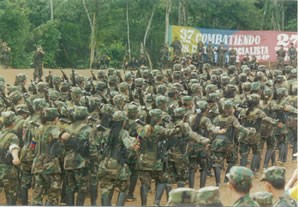
FARC guerrillas
FARC guerrillas marching in formation during the Caguan peace talks (1998–2002).
Renewed negotiations began on November 7, 1998, under
President Andres Pastrana, who granted FARC-EP a 42,000-square-kilometer (16,200-square-mile)
safe haven as a confidence-building measure. Unfortunately, the
peace talks ended on February 21, 2002, due to a series of high-profile
guerrilla actions, including the hijacking of an aircraft, sieges on a number
of small towns and cities, several political kidnappings, and the arrest of the
Irish Colombia Three, a group of IRA members who allegedly were training FARC-EP
militants to make bombs. Pastrana ordered the armed forces to start retaking
the FARC-EP controlled zone.
The Uribe and Santos Administrations
For most of the period between 2002 and 2005, the FARC-EP
was believed to be in strategic withdrawal due to the increasing military and
police actions of President Alvaro Uribe, which led to the capture or desertion
of many fighters and medium-level commanders. Uribe ran for office on an
anti-FARC-EP platform and was determined to defeat the guerrillas in a bid to
restore confidence in the country. Uribe’s own father was killed by FARC-EP
in an attempted kidnapping in 1983. Nonetheless, FARC interventions and
violence continued throughout Uribe’s administration and well into that of his
successor, Juan Manuel Santos.
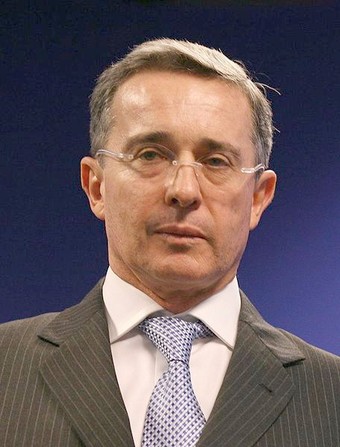
Álvaro Uribe
President Álvaro Uribe intensified military operations against the FARC-EP, seeking to defeat them.
Military offensives carried out under former President Uribe
and President Santos have significantly reduced the number of FARC
combatants and FARC territorial control, pushing guerrillas to more
remote and sparsely populated regions, often close to territorial or internal
borders. On June 23, 2016, a ceasefire accord was signed between the FARC-EP
and Colombian government. Under the accord, the Colombian government agreed to
support massive investment for rural development and facilitate the FARC’s
reincarnation as a political party. FARC promised to help to eradicate illegal
drug crops, remove landmines in areas of conflict, and offer reparations to
victims. FARC leaders can avoid prosecution by acts of reparation to victims
and other community work. However, during a referendum held October 2, 2016,
Colombians voted to reject the peace deal with FARC by 50.2% to 49.8%.
The government met with victims and peace opponents after
the referendum was rejected, receiving over 500 proposed changes, and continued
to negotiate with FARC. A revised agreement was announced on November 12, 2016,
which would require parliamentary approval rather than a nationwide referendum.
Among the reported 60 new or modified terms was a provision for FARC assets to
be distributed for victim compensation. FARC members would be able to establish
a political party and be granted full immunity for full confession and
cooperation, although drug trafficking would be assessed on a case-by-case
basis. Peace terms would be enforced by a Special Justice for the Peace, who
would report to the Constitutional Court and not to an international body.
Additionally, both Parliament and the Special Justice would have the ability to
modify terms of the agreement as seen necessary.
The Colombian government and FARC signed the
revised peace deal on November 24, 2016, and Congress approved it on November
30, 2016.
